Plastic Waste Management in India: Challenges, Opportunities, and Roadmap for Circular Economy
1
Centre for Sustainable Materials Research and Technology, SMaRT@UNSW, School of Materials Science and Engineering, The University of New South Wales (UNSW), Sydney, NSW 2052, Australia
2
Director’s Research Cell, CSIR-National Environmental Engineering Research Institute, Nehru Marg, Nagpur 440 020, India
3
Commonwealth Scientific and Industrial Research Organisation (CSIRO), Australian Manufacturing and Materials Precinct, Clayton, VIC 3168, Australia
4
Commonwealth Scientific and Industrial Research Organisation (CSIRO), Black Mountain Science and Innovation Park, Acton, ACT 2601, Australia
*
Author to whom correspondence should be addressed.
Sustainability 2022, 14(8), 4425; https://doi.org/10.3390/su14084425
Received: 2 March 2022 / Revised: 28 March 2022 / Accepted: 30 March 2022 / Published: 8 April 2022
Abstract
Plastic waste (PW) is one of the most rapid-growing waste streams in municipal solid waste all over the world. India has become a global player in the plastic value chain. Despite low consumption, domestic generation and imports create a significant burden on the overall waste management system, which requires in-depth understanding of the scenario and pathways that can mitigate the crisis. Although Indian researchers have widely researched technology-related issues in academic papers, a substantial knowledge gap exists in understanding the problem’s depth and possible solutions. This review article focuses on current plastic production, consumption, and waste generation in India. This review article mainly analyzes data and information regarding Indian PW management and highlights some critical issues such as reverse supply chain, effective PW management, source-specific recovery, and PW rules in India. Comprehensively, this review will help to identify implementable strategies for policymakers and research opportunities for future researchers in holistic PW management and recycling in India, focusing on the circular economy and sustainable development goals.
1. Introduction
1.1. Plastic Production and PW
Plastics have become a global commodity due to their remarkable properties (durability, light weight, and good thermal and electrical insulation) and widespread application opportunities at low prices [1]. During the worldwide COVID-19 outbreak, the production of personal protective equipment (PPE) using plastics is a remarkable application [2]. In 1950, resin and fiber production was recorded to be 2 million tonnes (Mt), which increased to 380 Mt in 2015 [3] and then decreased to 367 Mt in 2020 due to the impact of COVID-19 on the industry [4]. Polypropylene (PP), one of the critical plastic polymers for consumer goods, accounted for 23% of global plastic production in 2018 [5]. The United Nations Environment Programme (UNEP) has reported that each year, globally, over 400 Mt of plastic waste is generated [6]. PW management is directly connected with several sustainable development goals (SDGs), as mentioned in Figure 1. From 1950 to 2015, it was estimated that 6.3 billion tonnes of PW were generated, out of which, only 9% was recycled, while 80% of the waste was disposed of in landfills or into natural ecosystems [7]. According to the latest statistics from the Organisation for Economic Co-operation and Development (OECD), from 2000 to 2019, global plastic waste generation was doubled, reaching 353 Mt [8]. Due to the COVID-19 pandemic, plastic waste generation skyrocketed, and according to the latest study conducted in 2021 by Benson et al. [9], global plastic waste generation reached 584 Mt (estimated). Lebreton and Andrady [10] predicted that by 2060, in a business-as-usual scenario, mismanaged plastic waste (MPW) generation will be 155–265 Mt per year. PW management is an emerging issue which requires the development of appropriate policy and management tools [11], and the status is critical for both developed and developing countries [12]. Global plastic production in Mt and the lifespan distribution of plastic products in various application fields is presented in Figure S1A,B, given in the Supplementary Materials for this article.
Figure 1. SDGs related to PW management [13].
PW has a complex structure, comprising various valuable composite materials, harmful emissions, and residual ash [14], and therefore, managing waste is complicated, as in many cases, the contamination of plastic with other types of waste limits its recyclability [15]. In many developing countries such as India, collection and segregation operations are conducted by multi-tier actors (the informal sector), which creates further difficulties in identifying the flow of waste and its traceability in the various waste streams [16], and also because of vast applications as an integral part of product manufacturing and processing [17]. The American Society of Plastics Industry has created a standard coding system to define and distinguish the critical types of plastic. There are around 50 unique kinds of plastics with hundreds of variations. These plastic products are categorized into seven groups: polyethylene terephthalate (PET), high-density polyethylene (HDPE), low-density polyethylene (LDPE), vinyl/polyvinyl chloride (PVC), polypropylene (PP), polystyrene (PS), and several more types of plastic products [18]. The chemical structure, resin identification code, general applications as a virgin material, toxic element presence in polymers, advantages, challenges, and utilization as recycled items of various polymers are presented in Table 1.
In the traditional linear economy, product consumption ends up generating a massive amount of waste. It requires careful consideration to utilize resources in the economy and minimize negative environmental impacts and pollution [19]. On the other hand, according to the Ellen MacArthur Foundation [20] “a circular economy is a systemic approach to economic development designed to benefit businesses, society, and the environment. In contrast to the ‘take-make-waste’ linear model, a circular economy is regenerative by design and aims to gradually decouple growth from the consumption of finite resources.” The “New Plastics Economy” initiative is organizing collaboration among over 1000 organizations worldwide to achieve a circular economy [21]. The vision for the new circular plastic economy and the systematic approach’s key activities are shown in Figure 2.
Products designed with plastic and polymer materials are used following the traditional “take–make–waste” model in the linear economy for single use only, which requires special attention and appropriate collection and disposal, as 10 million tonnes of PW per year is currently leaking into the natural ecosystem [22]. Incineration and/or energy recovery, landfilling, and leakage to the surrounding ecosystem account for 14%, 40%, and 32% of the disposal of PW, respectively [23]. A comparison of plastic-waste-management-related issues is summarized in Table 2 considering various countries.
1.2. Research Motivation and Scope of the Article
Studies on PW have investigated various aspects, and in recent years, the number of studies has increased exponentially, especially in the area of recycling [80]. Using the keyword “plastic waste” in the Web of Science (WoS) core collection database, it was found that a total of 15,243 articles were published from 1981 to March 2021 (including documents such as original research articles, review articles, and others). About 1220 articles were published in India between 1990 and March 2021. Figure 3 shows the distribution of the articles over this period. Review articles are critically important, as they provide a substantial understanding of potential growth in respective research areas and develop appropriate management strategies, which is helpful for policymakers. A study conducted by Liang, Tan, Song and Li [1] reported that microplastics found in the marine environment and post-consumer plastic packaging products were the two main emerging issues regarding PW, while recycling technologies and plastic pollution are the emerging research hotspots on the topic. Table S1 of the Supplementary Materials presents review articles published on PW in India covering a diverse range of topics relevant to this article.
1.3. Research Contribution of the Article
In this review, an overview of plastic production and consumption, the main consumption sectors, the assessment of PW management and generation, rules and regulations, marine and microplastic pollution, and extended producer responsibility (EPR) are detailed and discussed in the Indian context. This is one of the earliest reviews that analyzes areas for potential improvement, at least from a desk research point of view. Often, data are scattered and not readily available, making future generation estimation difficult using methods such as dynamic material flow analysis. This article focuses on effective and sustainable PW management, restructuring reverse supply chains, source-specific recovery, and the implications of EPR and PW. Waste-management- and microplastic-pollution-mitigating measures are discussed based on evidence from India. Section 5 provides an overview of this review article.
A comprehensive review is required to understand the full potential of PW generated in India and its subsequent application in various sectors (as recycled materials) to achieve a circular plastic economy, which is currently missing in academic papers. There are significant knowledge gaps from the Indian context in academic papers on how PW could be an essential waste stream in achieving a circular economy, with the plastic industry’s growth, consumption of plastic products, and disposal pattern of PW.
2. Research Methodology
This review article was prepared based on an extensive literature search using various sources such as Google Scholar, Web of Science, the Google search engine and the ScienceDirect database. To identify relevant articles through these sources, PW, waste plastic, India, circular economy, resource recovery, challenges, supply chain, volume and flow of PW, PW management in India, etc., were used as keywords. Within this search, a total of 1684 articles were initially identified. As technology for recycling (mechanical, feedstock, and chemical) plastic is changing rapidly, gray literature and websites would also be important information sources and must be taken into consideration. They may explain possible solution approaches for PW management and recycling in the Indian context and from a global perspective. In this review, NVivo, VOSviewer, and Microsoft Excel were employed to analyze the articles and information sources’ quantitative data.
3. Overview of Plastic Production and WASTE Management in India
3.1. Categories and Sources of PW
PW represents 8% of the total waste generated in India [18]. Aryan, et al. [81] mentioned that approximately 6137 tonnes of PW go uncollected per day in India, which flows through streets, roads, and beaches. Compared to 1970, PW in MSW had increased almost eightfold by the year 2005, while waste generation from paper increased less than twofold over this time frame [82]. However, there are low levels of the penetration of plastic products in the Indian market, particularly in rural areas [83]. Figure 4 A shows product-specific PW sources, and Figure 4B shows the main polymer types in PW composition in India.
3.2. Plastic Production Industry and Consumption in India
India, a federal union, constitutes 28 states and 8 union territories. With annual economic growth of 7.5%, India is one of the most rapidly growing G20 economies. It also has strong incentive support for infrastructure development and some of the most rapid urbanization in the world [84]. It is the third largest economy on a purchasing power parity (PPP) basis, worth USD 8.7 trillion [85]. India has the highest gross domestic product (GDP) and growth rate among the BRICS countries (Brazil, Russia, India, China, and South Africa). The industry sector represents the largest component of GDP growth [85]. More specifically, rapid economic, geographic, and demographic growth are the main drivers of dramatic growth in the petrochemical sector in India [86]. The Indian plastic industry’s value chain is categorized as having upstream and downstream sectors. The upstream polymer manufacturing sector adopted state-of-the-art technologies from global leaders, which resulted in developing competitive-sized manufacturing plants and global competitiveness. On the other hand, the downstream plastic processing industry comprises 75% of registered plastic processing units. Polymer consumption of the industrial sector accounts for 25% of total plastic consumption in India. Around 30% of recycled plastics are utilized in the downstream sector [87]. The structure of the plastic value chain in India is shown in Figure 5.
Figure 5. Structure of the Indian plastic industry [88].
According to data from the Plastindia Foundation [88], in 2016–2018, excluding engineering plastics and thermoplastics, demand for PP (32%), PE (33%), and PVC (21%) were the highest. Figure 6 shows the plastic manufacturing capacity in India based on the major polymer types. These are the main polymer sources that are accrued at the end of life and accumulate as waste in the built environment.
From Figure 6, it is evident that PP > HDPE > LLDPE > PET are the main polymer sources that are entering the plastic material supply chain, which will eventually emerge in the waste stream at considerable levels, with some leakages in material flows.
The per capita consumption of plastics in 2014–2015 among developed and developing countries, including India, showed that at 109 kg per capita, the USA is the largest consumer of plastic. Consumption in India was 11 kg per capita/year, whereas the global average was recorded at 28 kg [18]. Despite its low consumption of plastic, India is the second largest producer (14.17 million tonnes (Mt)) of plastic polymers in the world [1]. According to Makwana [86], it is estimated that every 1 kg/year increase in per capita consumption will require an additional 1.25 Mt of polymers in India. In India, about 2,500,000 sets of plastic-based personal protective equipment (PPE) per day have been required in the healthcare sector due to the COVID-19 pandemic [89]. Poor consumer behavior and awareness and a lack of infrastructure for decontamination and effective reprocessing have further limited reprocessing capabilities during the COVID-19 pandemic [89].
Plastic production and consumption in India are increasing at a very rapid pace, and the majority of production is related to HDPE, LDPE, and PP [90]. The western region consumed 47% of plastics in India, while the northern and southern regions consumed 23% and 21% of plastics, respectively, in 2013 [2,91]. Due to the growing industrial base for manufacturing and production, the consumption of various other types of plastics has increased to a great extent in recent years. In 2018–2019, consumption was 913 kilotonnes (kt), which increased to 964 kt in 2019–2020, with a year on year growth rate of 5.5% [88]. Figure 7 shows the consumption pattern of engineering and performance plastics in India for the financial year 2018–2019.
Figure 7. Engineering and performance plastic consumption in India in 2018–2019 (in kilotonnes) [88].
3.3. Plastic Consumption by Sectors
Steep growth rates of GDP and rapid urbanization will be the main reasons for sharp increases in the consumption of plastics in the near future [92]. Owing to their special and unique applications, plastics are increasingly becoming the material of choice for extensive use. The major growth drivers of the plastic consumption in India are agriculture, packaging (rigid and flexible), infrastructure, home and office furnishings, personal care products, surface coats, transport, electrical and electronics, industrial machinery, biomedical applications, food and beverages, and textiles [18]. Petrochemicals such as ethylene are used to produce polyethylene, which is one of the critical plastics in the manufacturing sector [93]. Figure 8 depicts the consumption of plastics in end-use sectors for the year 2018. The main applications in various sectors of different kinds of plastics are presented in Table 1. The main sources of plastic waste generated and the types of plastics are provided in Supplementary Table S4.
Figure 8. Consumption of plastics in different sectors in India 2018 [88].
3.3.1. Packaging Industry
The packaging industry represents the largest sector for plastic use in India, accounting for 59%, present in nearly half of all packaged items [90]. The packaging industry uses both flexible and rigid types of packaging, where flexible packaging comprises either monolayer or multilayer films of plastic in which PE, PET, PVC, and PP which are used in multilayered laminated sheets, and rigid packaging is utilized for corrugated and paperboard boxes, plastic bottles and boxes, aluminum cans and glass jars [74]. The shares of the various polymer types used in the packaging industry show that 33% of the plastics are PE, 29% PP, 17% PET, 7% PVC, and 14% others. The demand growth drivers are processed food, fast-moving consumer goods, packaged food/beverages and the fast-food industry, single-use packs, fibers, and toys [85].
3.3.2. Agricultural Sector
PE, LLDPE, LDPE, HDPE, PVC, and PP are the plastics used in agriculture, water management, and related applications. The agriculture sector consumes a wide range of plastics in the form of plasticulture, which comprises agriculture and horticulture. Different types of plastics are used for different purposes, for example, in drip and sprinkler irrigation, PVC, LLDPE, HDPE, and PP are used, while for greenhouses, PVC, LDPE, LLDPE, HDPE, and PP are used. Low tunnel applications use LDPE, HDPE, and PP, whereas for mulching, LLDPE and PP are used [92].
3.3.3. Construction and Infrastructure
The construction and infrastructure sector contributes a significant amount of PW to the environment. Several kinds of plastics are used in these industries for the application of various products. Most PW in these industries is composed of LDPE, but there is also a significant amount of HDPE and PP [94]. The major growth drivers are building and construction, public utilities services, mega highway projects, rural electrification projects, mega irrigation projects, smart cities, etc. [85].
3.3.4. Automobile Manufacturing Sector
High-performance plastics are gaining importance in the automotive industry, and this is expected to increase in the future. The primary feature of the high-performance selection of plastic compared to other materials is their utilization in automobiles, functionality, economic features, and reduced fuel consumption [95]. PP, ABS, PBT, PA, and PE are the major types of plastics used in this sector for various applications, such as bumpers, vehicle seats, fuel systems, automotive bodies, lighting, electrical insulation, etc. Andhra Pradesh, Telangana, Haryana, Himachal Pradesh, Jharkhand, Kerala, Madhya Pradesh, Punjab, Rajasthan, Uttar Pradesh, Uttarakhand, Karnataka, Tamil Nadu, West Bengal, Gujarat, and Maharashtra are the main automobile manufacturing hubs in India. Table S2 of the Supplementary Materials shows the plastic use in various components in automobiles.
3.3.5. Plastics from the Biomedical Sector
India is considered a medical tourism destination, and there is growing awareness of healthcare products among consumers [85]. Plastic products used in the biomedical sector for various applications include gloves, syringes, IV tubes, catheters, inflatable splits, etc. Heart valves, hearing aids, spectacles, prosthetics, devices, packaging of medicines, etc., are the main applications of plastics in the healthcare sector [85]. PE, PP, PS, polyester, (PLA and other biosorbable plastics), PC, PVC, polyethersulfone, polyacrylate (acrylic, PMMA), hydrogel (acrylate), polysulfone, polyetheretherketone, and thermoplastic elastomers (TPE, TPU) are known as medical device polymers [96]. Acetal, PC, PETG, HDPE, and PP are the main plastic polymers used in medical equipment [97].
3.3.6. Electrical and Electronic Equipment (EEE) Manufacturing Industry
Greater disposable income, higher per capita income, and healthy economic growth are the major drivers of growth in consumer durables such as washing machines, refrigerators, computers, mobile phones, smart TVs, notebooks, digital cameras, invertors and UPS, USB, STBs, and LCD. Various types of plastics are used in electronics, such as PS, used in large cooling appliances, ABS in CRT monitors, printers, copying machines, CPUs, etc. After EEE appliances reach their end of life, however, due to the rigid nature of the components, the plastics used in manufacturing become waste in the PW stream.
3.3.7. Solar PV and LED Manufacturing Sector
Ethylene vinyl acetate (EVA) is a specially designed and manufactured polymer that has a highly transparent (plastic) layer used to encapsulate solar cells and hold them in place during solar panel manufacturing. Due to the impact-resistant, “glass-like” surface of polycarbonate (PC) plastic, which is a naturally transparent and amorphous thermoplastic, it is widely used in light-emitting diode (LED) manufacturing [98]. LED bulbs (Retrofits), tube lights, and street lamps are the main products driving growth in demand for LEDs, and the market is growing at 35% each year [85].
3.4. Assessment on PW Management and Generation in India
Due to unpreceded growth in consumerism across India, waste management has become a critical issue in India, like any other country in the world [99]. Currently the size of the plastic industry in India is 110,000 crores, which involves around 30,000 companies and/or units. However, scrap contamination and outdated and inadequate municipal infrastructure result in poor-quality PW that could be used as a raw material for various products [2]. Furthermore, there is limited availability of appropriate technologies in the market, which restricts the maximum waste recovery. In addition, the import of segregated scrap has an impact on the local recycling industry. Overall, the PW supply chain is considered a broken supply chain in India [100].
3.4.1. PW Generation in India
Every year, India generates 15 Mt of PW, of which, only one-quarter is recycled [101]. The majority of PW in India is dumped in unmanaged landfills, which is a major source of groundwater contamination [18]. Sikka [102] claimed that India’s recycling rate for PW is approximately 60%, which is higher than some other countries such as China (10%), Japan (12%), Europe (7%), the USA (10%), and South Africa (16%). On the other hand, Siddiqui and Pandey [55] found that between 5% and 25% of PW was being recycled. As of 2014, collection efficiency was estimated at 80.28%, out of which, only 28.4% was being treated [18]. Figure 9 shows PW generation in India from 2012 to 2019 based on data reported by various states. It was found that until 2019, most states had not reported PW generation in their respective state. Among the states, with a few exceptions, Punjab, Andhra Pradesh, and Gujarat regularly reported PW generation-related data to the Central Pollution Control Board of India.
As of 2016, the total generation of PW in India was 17481 kilotonnes (kt), while 167 kt and 3 kt were imported and exported, respectively, that year [1]. Figure 10 shows the population distribution and PW generation in India, based on data available from the Centre for Science and Environment [108] for the financial year 2018–2019. Uttar Pradesh, Maharashtra, and Tamil Nadu are the three major states where both population and PW generation are high. The national average was recorded as 3.36 Mt of waste for the year. In Goa, per capita per day PW generation is close to 60 g, which is much greater than the national average of 8 g.
Figure 10. (A) Population (as per census 2011) and (B) PW generation (in tonnes) in various states in India in the financial year 2018–2019 (data source: [108]).
In 2016, Asian countries imported 74% of the world’s PW, and India is the fifth largest PW importer in Asia [1]. India is an importer of PW, along with China and Turkey in Asia [1]. Figure 11 shows that the USA and European countries are the dominant stakeholders in the PW supply chain. Reductions in permits, the closure of illegal recycling facilities, and bans on importing waste plastics are some of the critical steps that India and other countries such as Vietnam, Thailand, Malaysia, and the Philippines have taken to limit the transboundary movement of PW [1].
Figure 11. Major PW exporters in India in 2017. Data source: Liang, Tan, Song and Li [1].
3.5. Aquatic Pollution and Microplastics in India
Every year, 8 Mt of PW is leaked into oceans [23]. The coastline of India extends to 7500 km, excluding the islands along the Bay of Bengal in the east and the Arabian Sea in the west [109]. These coasts face threats due to increasing population growth, industrialization, tourism, and economic growth, which are further contributing to the introduction of plastics into the oceans through different routes which may cause harm to the environment and human health. Marine pollution is affecting almost all ocean basins, freshwater, and terrestrial environments. Discharge from rivers is one of the most crucial sources of plastic pollution into oceans due to the unidirectional flow of rivers [110]. Contaminants found in the marine environment are dominated by six types of polymers, namely PP, PVC, PE, PET, polyurethane (PU), and PS, which, when combined, account for 80% of the total plastic production [111]. The major source of marine pollution is land-based coastal pollution that is within 50 km of a coastline; it contributes more than 80% of marine pollution, 90% of which is PW, and mostly single-use plastics [2,111]. Among all the sources of marine pollution, microplastics are omnipresent and ubiquitous. This has recently attracted concern because they not only find their way into the aquatic environment but are often readily consumed by marine organisms and also serve as vectors inside the food chain for the chemical transfer of pollutants and cause deaths of organisms because of their toxicity [109,112]. The sources of marine pollution are shown in Figure 12, where sea-based activities comprise fishing litter (66%) and shipping litter (34%).
Figure 12. Sources of marine pollution [113].
A report presented by Bhattacharya, Chandrasekhar, Roy and Khan [18] mentioned that in India, annually, out of 5.6 Mt, 0.6 Mt of PW ends up in the sea. There are nine coastal states in India, namely Gujarat, Maharashtra, Goa, Karnataka, Kerala, Tamil Nadu, Andhra Pradesh, Odisha, and West Bengal; two union territories, Daman and Diu and Puducherry; two island territories, the Andaman and Nicobar Islands (Bay of Bengal) and Lakshadweep (Arabian Sea). There are also sixty-six coastal districts in mainland India, three in the Andaman and Nicobar Islands, and one in Lakshadweep Island (Indian Institute of Ocean Management). The coasts near Mumbai, Kerala, and the Andaman and Nicobar Islands are among the worst polluted seas in India [18]. Nelms, et al. [114] found that on the riverbank that stretches from the coast of Bangladesh to the Himalayas in India, fishing gear is the most fundamental source of PW pollution in the region. Inefficient regulations and policies related to fisheries and inappropriate ways to dispose of fishing gear were also identified. Illegal gear types, restricted net mesh sizes, short gear lifespans, and high turnover rates were found to be some of the major bottlenecks of fishing practices and subsequently the generation of fishing-gear-related debris. Similar research by Raha, et al. [115] showed that existing law and policy measures on marine plastic pollution (MPP) in the Gangetic delta region of the Bay of Bengal have numerous ambiguities and inadequate implementation efforts. The authors suggested that powerful waste management approaches, instinctive involvement of the public, and appropriate national marine litter policies are required for the minimization of MPP in India (Singh, 2018). Indian states’ contribution towards PW in the Ganges River is shown in Table S3 of the Supplementary Materials of this article.
Microplastics as Pollutants
Based on the size of the plastics, there are two categories of plastics, namely macroplastics and microplastics. Macroplastics are larger plastic items (≥25 mm), whereas microplastics are smaller items (≤5 mm). Microplastics are often referred to as a “cocktail of contaminants” due to their ability to adhere to several other additives which may be added or produced during the manufacturing of different products, heavy metals, and other persistent organic pollutants (POPs) that are available in the environment [116]. Microplastics are further classified as primary microplastics and secondary microplastics. PE, PP, PET, PS, PVC, nylon, PU, and PA are the main polymer types found as microplastics in India [109]. Primary microplastics are those that enter the environment directly through different means such as extrusion or grinding, as feedstock for the manufacture of products or direct use, whereas secondary microplastics are derived from the fragmentation of larger plastic remains [109]. It was estimated that 12.2 Mt of total plastic entered the marine environment in 2015, out of which, 94% of these plastics reached the sea floor, 5% washed onto beaches, and the remaining 1% was found to be floating on the ocean surface [2].
About 8 Mt of total microplastics and 1.5 Mt of primary microplastics are estimated to enter the marine environment annually [116]. Primary microplastics are manufactured and used for different cosmetic products, toothpaste, etc., whereas secondary microplastics are the result of the breakdown of bigger plastics due to UV radiation, wind, currents, and microbial activity [110]. Figure 13 shows the polymer composition along various coastal regions in India.
Most of the plastic trash entering the oceans is picked up by major rivers in India as they move downstream. The majority remains in coastal waters, but the remainder can be carried around the world through ocean currents [109].
Micro- and nano-plastics result from floating waste that is exposed to UV radiation and fragments into smaller particles. Trillions of such particles are dispersed throughout the ocean and unintentionally ingested by all kinds of aquatic species, including the planktonic community [110]. This pervasiveness has detrimental impacts on both public and environmental health, as these organisms are at the foundation of the aquatic food web. Plankton also play a critical role in absorbing carbon dioxide through photosynthesis and transferring it to the deeper ocean layers. As micro- and nano-plastics contaminate plankton populations, the capacity of ocean storage of carbon dioxide is greatly affected.
Being hydrophobic and exhibiting high surface-area-to-volume ratios, these tiny plastic particles are more likely to adsorb organic pollutants and act as either sinks or sources of contamination in organisms. Another huge problem is that it is extremely difficult to monitor and clean them up.
To combat the potential hazards of micro- and nano-plastics, degradation pathways for plastic must be fully understood. In addition, deeper insights into the mechanism are crucial in implementing proper waste disposal strategies.
Plastic degradation can follow either abiotic or biotic paths. The theory of abiotic degradation is well established, but less is known about experimental evidence of such an occurrence at the nanoscale. Recently, investigations into polymer degradation have been established at a fast-growing rate, but many of these were carried out under extreme conditions that are not environmentally realistic. Therefore, laboratory confirmation of nano-plastic occurrence in experiments replicating environmental conditions is of key importance in this field.
3.6. PW Management Rules in India
PW-related regulations in India have evolved over the years, dating back to the identification of the importance of solid waste management systems in 1960. Figure 14 shows the states that have initiated single-use PW-related bans. In 2011, PW rules were enacted under the Environmental Protection Act of 1986. The rules replaced the earlier rules, the Recycled Plastics Manufacture and Usage Rules 1999, which were previously amended in 2003 [82]. All states are held equally responsible to manage their PW and follow the PW management rules given by the government. Figure 15 shows the practical module of the PW management rules in India, and Figure 16 shows the timeline of PW rules with their respective salient features.
Figure 14. Ban on single-use plastics in different states [107].
Figure 16. Timeline for plastic waste management rules over the years and their salient features. Data sources: (India Government Portal, 1999; CPCB, 2013, 2016, 2018; MoEF, 2021). Accessed on 15 January 2021.
According to the PW management rules (2016) and the PW management (amendment) rules (2018), it is forbidden to import scrap plastic of non-halogenated polymers and co-polymers, including but not limited to PP, PET, etc., polymers that are hazardous and specified under schedule VI [1]. The rules are enforced by the Ministry of Environment, Forest and Climate Change (a dedicated organ of the Govt. of India (GOI)), taking into consideration Sections 3, 6, and 25 of the Environment (Protection) Act (1986) [115]. The Indian Government introduced two amendments to the Hazardous Waste (Management and Transboundary Movement) Rules, 2016, which impose a complete prohibition of PW imports into the country, including to special economic zones and export-oriented areas. In March 2021, the draft PW management rules, 2021, were issued by the Union Ministry of Environment, Forests and Climate Change (MoEFCC), re-defining the thickness of carry bags. Figure 17 shows the major environmental rules for PW in India with state-level initiatives on PW bans.
3.7. Extended Producer Responsibility (EPR)
According to the Organization for Economic Co-operation and Development (OECD), “Extended Producer Responsibility (EPR) is a policy approach under which producers are given a significant responsibility—financial and/or physical—for the treatment or disposal of post-consumer products” [121]. Under the concept, producers are liable for the environmentally sturdy management of products until the end of life (EOL), which includes setting the modalities for waste collection systems based on EPR. Both State Urban Development Departments and other local bodies are collectively and individually involved in the waste collection process to improve recycling. At present, three distinct EPR models are proposed. Manufacturers, importers, and brand owners (who introduce the products) are primarily responsible for collecting multilayered plastic sachets or pouches or packaging plastics in India.
Model 1 is proposed based on the “Buy-Back Depository Mechanism”, which includes a buy-back price mentioned for plastic products that allow consumers to retrieve an allocated amount upon returning plastic products (Figure 18A). This model is predominately a producer-, retailer-, and consumer-oriented collection and recycling system. Setting up collection centers (e.g., reverse vending machines (RVMs) or crushing machines and recycling units of optimum capacity) is the primary task for manufacturers/producers. It is believed that under this model, consumers are incentivized (not to discard plastic litter) and retailers/producers are encouraged to enhance their recycling efforts. “Deposit return schemes” that are widely practiced in Germany and England are considered as an implementation strategy. Furthermore, RVMs provide opportunities for consumers to dispose of acceptable shapes and sizes of various types of PW. A barcode on disposed-of products/packaging may be used for tracking, requiring agreement of the producers and retailers, as part of the EPR model [122]. Another model is proposed which is based on the contribution of producers/importers/brand owners in the EPR corpus fund, supervised by the central government. The amounts of financial contributions will depend on the amount of plastic being introduced into the market by the stakeholders. However, in terms of flexible packaging waste, an EPR scheme should adopt changes in recycling initiatives for effective control [123]. Figure 18B shows the proposed model and actors involved in the process. Under the third proposed model (Figure 18C), targets will be assigned to producers or Producer Responsibility Organizations (PROs) based on the volume of plastics they introduce into the market; in this case, an instrument called “Plastic Credit” is proposed as evidence of recycling or recovery by the producers. Under this model, producers are not directly involved in the recycling or recovery process; however, they need to make sure that a correspondent volume of plastic is being reprocessed/recycled. The credit will be issued with the help of accredited processors exchanging financial transactions to producers or PROs. The fund will be then utilized for the environmentally sound end-of-life management of PW. One of the primary targets of this model is to develop a marketplace for tradable plastic credits.
4. Discussion
4.1. Effective and Sustainable PW Management Strategies
The lack of a functioning solid waste management system is one of the critical barriers, as only one-quarter of PW is recycled in India. The impact is far more widespread, as improper disposal creates burdens on landfills and poses health-related challenges to waste pickers, who are mostly women [101]. Despite high collection efficiency (80.28%, as seen in Section 3.4.1), the treatment rate is very low (28.4%) as there might be large-scale contamination of other materials with PW sources. There should be widespread concern over workers’ safety and the environment around recycling centers in the small-scale downstream fragmented sector. In order to substantially improve the current scenario, infrastructure, enforcement, robust and stringent waste management tools, and the availability of affordable alternatives are the main implementation challenges in India. Although the PW management rules highlight rural areas from a management perspective, capacity building and rendering technology have not been adequately prescribed. A similar approach is not evident in coastal areas. For example, in the Andaman and Nicobar Islands, a complete ban on plastic bags has been imposed; however, there are no recycling units available. Banning plastics could create economic stagnation in the long term. Bans or regulations must consider the availability of infrastructure and management strategy. The development of waste management strategies and maintaining the material market value of recycled materials are critically important [124]. The UNDP [125] has proposed an integrated approach to PW management and recycling in which baseline model design and adjustment would be built on LCA, along with consumption data and regulations.
4.2. Restructuring Reverse Supply Chain
A feedback mechanism in terms of quality and market requirements for recycled plastics from end-user industries could help institutionalize and organize recyclers and plastic processors. For India, the primary resource recovery challenges lie within the area of socio-technical model development, transforming the informal sector to the formal economy, the establishment of material recovery facilities, support structures and institutional framework development for the population related to waste picking, and finally, the implementation of a technology-supported knowledge management system for waste management. Downcycling is the main current path to utilize waste plastics [99].
Further assessment and reverse logistics optimization are required on how PW can be economically transferred to the states for higher recycling rates. As the informal sector is involved in waste collection, uncertainties could be integrated into open-loop and closed-loop reverse distribution models assessing the viability of inter-state PW processing. Location-allocation, cost, product recovery, secondary markets, and after-sales services are some of the essential issues in designing a model [126]. In a reverse logistics network planning and closed-loop supply chain, additional states should be considered along with the recycling facilities located in Gujarat (Dhoraji, Daman, and Vapi), Madhya Pradesh (Indore), Delhi, and Maharashtra (Malegaon, Solapur, and Mumbai (Dharavi and Bhandup)). In energy and transport in urban settings, efficiency is the major issue which creates limited resource-recovery opportunities through large-scale centralized plastic sorting and recycling facilities [127]. Micro-factories at a local scale could reduce the barriers [128].
4.3. Source-Specific Waste Recovery
From the analysis in this review article, it is revealed that PE, PET, PP, and PVC are the main polymer types used in the packaging industry, while PE, LLDPE, LDPE, HDPE, PVC, and PP are the main polymers used in the agricultural sector. LDPE, HDPE, and PP are the main polymers used in construction and infrastructure. In the automobile sector, PS, ABS, PC/PBT, PP, PUR, PVC, PA, SMA, PPE, HDPE, POM, UP, ASA, and PMMA are the major polymers utilized. Source-specific waste reduction should be one of the priorities for policymakers in India, and both industrial and household sources should be identified and eliminated. Depending upon the lifespan of products, both short- and long-term planning are required. Resource recovery from food packaging, considering PE, PET, PVC, and PP, should be the highest priority. Recycling and waste elimination from multilayer food packaging is one of the main challenges for the Indian PW management system. Reprocessing technologies, sorting, and separation around food packaging should be taken into consideration. Improved sorting and reprocessing systems are essential for quality improvement in recycled plastics [129].
4.4. EPR- and PW-Related Rules
Although EPR was introduced in the 2016 PW management rules, and subsequently in the 2018 amendment, there is a lack of clarity regarding roles, responsibilities, and proper guidelines for producers, importers, and plastic products manufacturers. Furthermore, there is a need for real-time monitoring and clear mapping of the producers and associated state-wise plastic demand and supply, which might provide achievable and accountable EPR targets [18]. Developing a collect-back system is also a critical issue mentioned in the rules, which requires collaboration among producers, importers of plastic carry bags/multilayered packaging, and local municipalities. However, this requires the development of a monetized collection model which provides economic benefits to all actors [34]. Liang, Tan, Song and Li [1] found that for sustainable waste management, cost and participation are the main influencing factors, and collection and recycling process optimization and incentives for social participation are the main challenges in this area. Using consistent monitoring, review, and verification mechanisms, yearly and future projection reports of waste generation amounts, coupled with implementation of the rules and EPR policy would ensure the accountability of waste generators (importers/manufacturers) and ULBs [2]. Black plastics have received significant attention among the international research community, as there is a lack of information on heavy metal migration into sinks and difficulties in sorting at MRF (Turner, 2018). Improving/introducing regulations and policies for single-use black food packaging should be given priority in the rules. Collecting data and information on and the characterization of black plastic is an essential step in such a context [130].
4.5. Microplastic Pollution Mitigation
The Ad Hoc Open-Ended Expert Group (established under UNEP/EA.3/Res.7 on marine litter and microplastics) suggested that coherence, coordination, and synergies between existing mechanisms are crucial for addressing the challenges of marine plastic pollution and microplastic pollution at local, national, regional, and global levels [131]. Critchell, et al. [132] found that a lack of understanding of plastic’s entire product lifecycle (flow of plastics in the natural ecosystem) creates an environmental challenge in coastal areas for microplastics.
5. Conclusions and Outlook
PW management and recycling is the primary concern in India, and the implementation of EPR is the primary task that needs to be fulfilled. As EPR requires manufacturers and importers to interact directly with the supply chain, recycling-oriented product design should be the priority for these stakeholders. In addition, flows of plastic from overseas often overburden the whole system, requiring controlled monitoring to identify the flow and quality of waste entering the country. Local councils and states that are located along coastlines require an active role in minimizing the environmental impact and leakage of plastic waste into land and marine ecosystems.
The legal aspects of waste should provide a more precise and concise outlook regarding the PW supply chain’s role and responsibilities. Particular attention should be given to integrating informal recyclers into formal collection and recycling channels and implementing unique recycling technology for multiplayer plastic polymers. The baseline assessment of mismanaged single-use plastic is crucial, along with regulatory, economic, awareness, and voluntary interventions.
Furthermore, capacity building (in the source separation of polyolefinic waste and the reuse of plastics), infrastructural development (material recovery facilities at the micro-level in the country and the proper collection, segregation, and transportation of discarded plastic material), and financial support (incentives and innovative economic model) for chemical and biological recycling should be the priority of governments targeting PW, especially HDPE, LDPE, and PP. Particular attention to capacity building is required for rural areas while framing the PW rules. Upscaling and commercializing bio-based plastic is another aspect that requires further investigation, as the market share of such products will substantially increase in coming years, requiring strong collaboration between research and industry startups. Rather than seeking comprehensive solutions at the downstream end, upstream material management is critical for resource management and the circular economy, making consumer awareness and the mindset towards acceptability of recycled products equally important.
Supplementary Materials
The following supporting information can be downloaded at: https://www.mdpi.com/article/10.3390/su14084425/s1. Table S1: Summary of review articles published from India (2005 March 2021) [89,115,133,134,135,136,137,138,139,140,141,142,143,144,145,146,147,148,149,150,151,152,153,154,155,156,157,158,159,160,161,162,163,164,165,166,167,168,169,170,171,172,173,174,175,176,177,178,179,180,181,182,183,184,185,186,187,188,189,190,191,192,193,194,195,196,197,198,199,200,201,202,203,204,205,206,207,208,209,210,211,212,213,214,215,216,217,218,219,220,221,222,223,224,225,226,227,228,229,230,231,232,233,234,235,236,237,238,239]; Table S2: Plastic use in various components in automobile [240]; Table S3: Indian states contributing towards addition of PW into Ganges River [115]; Table S4: The types of plastics generated and produced in India. Figure S1: (A) Global plastic production from 1950–2014 and (B) plastic-related product lifespan distribution in various sectors [3,241]. References [3,89,115] are cited in the Supplementary Materials.
Author Contributions
Conceptualization, R.H. and V.S.; methodology, R.H. and M.T.I.; validation, R.H. and M.T.I.; formal analysis, R.H., M.T.I., A.G., R.S., D.K., R.D., K.E.S.L., H.S. and V.S.; investigation, R.H. and M.T.I.; writing—original draft preparation, R.H. and M.T.I.; writing—review and editing, R.H., M.T.I., A.G., R.S., D.K., R.D., K.E.S.L., H.S. and V.S.; visualization, M.T.I.; supervision, R.D., H.S. and V.S.; All authors have read and agreed to the published version of the manuscript.
Funding
India—Australia Industry and Research Collaboration for Reducing Plastic Waste through contract agreement.
Institutional Review Board Statement
Not applicable.
Informed Consent Statement
Not applicable.
Data Availability Statement
Data will be available on request.
Acknowledgments
The authors acknowledge project funding for India—Australia Industry and Research Collaboration for Reducing Plastic Waste through contract agreement.
Conflicts of Interest
The authors declare no conflict of interest.
References
- Liang, Y.; Tan, Q.; Song, Q.; Li, J. An analysis of the plastic waste trade and management in Asia. Waste Manag. 2021, 119, 242–253. [Google Scholar] [CrossRef] [PubMed]
- TERI. Plastic Waste Management: Turning Challeges into Opportunities. Available online: https://www.teriin.org/sites/default/files/2020-12/plastic-management_0.pdf (accessed on 15 January 2021).
- Geyer, R.; Jambeck, J.R.; Law, K.L. Production, use, and fate of all plastics ever made. Sci. Adv. 2017, 3, e1700782. [Google Scholar] [CrossRef] [PubMed][Green Version]
- Tiseo, I. Global Plastic Production 1950–2020. Available online: https://www.statista.com/statistics/282732/global-production-of-plastics-since-1950/ (accessed on 26 March 2022).
- Tiseo, I. Distribution of Plastic Production Worldwide in 2018, by Type. Available online: https://www.statista.com/statistics/968808/distribution-of-global-plastic-production-by-type/ (accessed on 24 March 2021).
- UNEP. Single-Use Plastics: A Roadmap for Sustainability. Available online: https://www.unep.org/resources/report/single-use-plastics-roadmap-sustainability (accessed on 19 August 2021).
- Brooks, A.L.; Wang, S.; Jambeck, J.R. The Chinese import ban and its impact on global plastic waste trade. Sci. Adv. 2018, 4, eaat0131. [Google Scholar] [CrossRef] [PubMed][Green Version]
- OECD. Plastic Pollution is Growing Relentlessly as Waste Management and Recycling Fall Short, Says OECD. Available online: https://www.oecd.org/environment/plastic-pollution-is-growing-relentlessly-as-waste-management-and-recycling-fall-short.htm#:~:text=Global%20plastic%20waste%20generation%20more,11%25%20from%20clothing%20and%20textiles (accessed on 26 March 2022).
- Benson, N.U.; Bassey, D.E.; Palanisami, T. COVID pollution: Impact of COVID-19 pandemic on global plastic waste footprint. Heliyon 2021, 7, e06343. [Google Scholar] [CrossRef]
- Lebreton, L.; Andrady, A. Future scenarios of global plastic waste generation and disposal. Palgrave Commun. 2019, 5, 6. [Google Scholar] [CrossRef][Green Version]
- Singh, P.; Sharma, V. Integrated plastic waste management: Environmental and improved health approaches. Procedia Environ. Sci. 2016, 35, 692–700. [Google Scholar] [CrossRef]
- Wang, C.; Zhao, L.; Lim, M.K.; Chen, W.-Q.; Sutherland, J.W. Structure of the global plastic waste trade network and the impact of China’s import Ban. Resour. Conserv. Recycl. 2020, 153, 104591. [Google Scholar] [CrossRef]
- Westerbos, M. How the Sustainable Development Goals Can Help Fight ‘Plastic Soup’. Available online: https://bthechange.com/how-the-sustainable-development-goals-can-help-fight-plastic-soup-3ce746fc1cba (accessed on 30 March 2021).
- Faraca, G.; Astrup, T. Plastic waste from recycling centres: Characterisation and evaluation of plastic recyclability. Waste Manag. 2019, 95, 388–398. [Google Scholar] [CrossRef]
- Eriksen, M.K.; Pivnenko, K.; Olsson, M.E.; Astrup, T.F. Contamination in plastic recycling: Influence of metals on the quality of reprocessed plastic. Waste Manag. 2018, 79, 595–606. [Google Scholar] [CrossRef]
- Kumar, A.; Samadder, S.; Kumar, N.; Singh, C. Estimation of the generation rate of different types of plastic wastes and possible revenue recovery from informal recycling. Waste Manag. 2018, 79, 781–790. [Google Scholar] [CrossRef]
- Balaji, A.B.; Liu, X. Plastics in Circular Economy: A Sustainable Progression. In An Introduction to Circular Economy; Liu, L., Ramakrishna, S., Eds.; Springer: Singapore, 2021; pp. 159–178. [Google Scholar]
- Bhattacharya, R.; Chandrasekhar, K.; Roy, P.; Khan, A. Challenges and Opportunities: Plastic Waste Management in India. Available online: https://archive.nyu.edu/handle/2451/42242 (accessed on 15 January 2021).
- Sheldon, R.A.; Norton, M. Green chemistry and the plastic pollution challenge: Towards a circular economy. Green Chem. 2020, 22, 6310–6322. [Google Scholar] [CrossRef]
- Ellen MacArthur Foundation. The Circular Economy in Detail. Available online: https://archive.ellenmacarthurfoundation.org/explore/the-circular-economy-in-detail (accessed on 19 August 2021).
- Ellen MacArthur Foundation. New Plastic economy—A Circular Economy for Plastic in Which it Never Becomes Waste. Available online: https://www.ellenmacarthurfoundation.org/our-work/activities/new-plastics-economy (accessed on 26 March 2021).
- Boucher, J.; Billard, G. The challenges of measuring plastic pollution. Field Actions Sci. Rep. J. Field Actions 2019, 68–75. [Google Scholar]
- Ellen MacArthur Foundation. Plastics and the Circular Economy. Available online: https://www.ellenmacarthurfoundation.org/explore/plastics-and-the-circular-economy (accessed on 10 March 2021).
- Worldbank. Population—All Countries and Economies. Available online: https://data.worldbank.org/indicator/SP.POP.TOTL (accessed on 26 March 2022).
- Trading Economics. European Union Population. Available online: https://tradingeconomics.com/european-union/population#:~:text=Population%20in%20European%20Union%20is,macro%20models%20and%20analysts%20expectations (accessed on 26 March 2022).
- Rafey, A.; Siddiqui, F.Z. A review of plastic waste management in India—Challenges and opportunities. Int. J. Environ. Anal. Chem. 2021, 1–17. [Google Scholar] [CrossRef]
- Tiseo, I. Annual Production of Plastics in Europe from 1950 to 2020. Available online: https://www.statista.com/statistics/987838/plastics-production-volume-in-the-eu-28/#:~:text=Europe%20produced%20roughly%2055%20million,to%20367%20million%20metric%20tons (accessed on 26 March 2022).
- Ian Tiseo. Production Volume of Plastic Products in China from 2012 to First Half of 2021. Available online: https://www.statista.com/statistics/1255628/plastic-product-production-in-china/#:~:text=In%202020%2C%20China’s%20total%20production,plastics%20production%20as%20of%202019 (accessed on 26 March 2022).
- Punjab Board of Investment & Trade (PBIT). Plastic Industry of Pakistan: Prospects and Challenges amid Coronavirus Crisis. Available online: https://pbit.punjab.gov.pk/system/files/Plastic%20Industry-Prospects%20and%20Challenges%20amid%20coronavirus%20crisis_Marketing%20Dept_2nd%20Ed-May2020(1).pdf (accessed on 26 March 2022).
- Tiseo, I.U.S. Plastics Industry—Statistics & Facts. Available online: https://www.statista.com/topics/7460/plastics-industry-in-the-us/#dossierKeyfigures (accessed on 26 March 2022).
- Alves, B. Brazil: Processed Plastics Production 2010–2019. Available online: https://www.statista.com/statistics/486298/processed-plastics-production-in-brazil/#:~:text=The%20production%20of%20processed%20plastics,experienced%20an%20overall%20downward%20trend (accessed on 26 March 2022).
- Babayemi, J.O.; Nnorom, I.C.; Osibanjo, O.; Weber, R. Ensuring sustainability in plastics use in Africa: Consumption, waste generation, and projections. Environ. Sci. Eur. 2019, 31, 60. [Google Scholar] [CrossRef][Green Version]
- Department of Agriculture Water and Environment. Australian Plastics Flows and Fates Study 2019–20—National Report. Available online: https://www.awe.gov.au/sites/default/files/documents/apff-national-report.docx (accessed on 27 March 2022).
- TERIIN. Fact Sheet on plastic waste in India World Environment Day. Available online: https://www.teriin.org/sites/default/files/files/factsheet.pdf (accessed on 27 March 2022).
- Shreeshan Venkatesh; Kukreti, I. An Indian Consumes 11kg Plastic Every Year and an Average American 109 kg. Available online: https://www.downtoearth.org.in/news/waste/an-indian-consumes-11-kg-plastic-every-year-and-an-average-american-109-kg-60745 (accessed on 27 March 2022).
- Amadei, A.M.; Sanyé-Mengual, E.; Sala, S. Modeling the EU plastic footprint: Exploring data sources and littering potential. Resour. Conserv. Recycl. 2022, 178, 106086. [Google Scholar] [CrossRef]
- Jiang, X.; Wang, T.; Jiang, M.; Xu, M.; Yu, Y.; Guo, B.; Chen, D.; Hu, S.; Jiang, J.; Zhang, Y.; et al. Assessment of Plastic Stocks and Flows in China: 1978–2017. Resour. Conserv. Recycl. 2020, 161, 104969. [Google Scholar] [CrossRef]
- Ahmed, S.I. Problems with Plastic. Available online: https://www.thenews.com.pk/tns/detail/567702-problems-plastic#:~:text=This%20growth%20is%20also%20due,the%20country%20is%206.5%20kg (accessed on 27 March 2022).
- Hundertmark, T.; Prieto, M.; Ryba, A.; Simons, T.J.; Wallach, J. Accelerating Plastic Recovery in the United States; McKinsey Co. Chem: Minato, Tokyo, 2019. [Google Scholar]
- Bluevision. Brazil Performs Well in Plastic Collection, but Poor Recycling. Available online: https://bluevisionbraskem.com/en/intelligence/brazil-performs-well-in-plastic-waste-collection-but-poor-recycling/ (accessed on 27 March 2022).
- WWF. Don’t Let Nature go to Waste—Australia, It’s Time to End Single-Use Plastic. Available online: https://www.wwf.org.au/get-involved/plastics (accessed on 27 March 2022).
- Tiseo, I. Distribution of Plastic Waste Generation in Europe in 2018, by Sector. Available online: https://www.statista.com/statistics/986584/distribution-of-plastic-waste-collected-in-europe/ (accessed on 27 March 2022).
- Plastics Europe. Plastics—The Facts 2021. Available online: https://plasticseurope.org/wp-content/uploads/2021/12/Plastics-the-Facts-2021-web-final.pdf (accessed on 27 March 2022).
- Davey, R. Plastic Waste Management in China. Available online: https://www.azom.com/news.aspx?newsID=58319#:~:text=According%20to%20estimates%20from%20the,was%20generated%20in%20the%20country (accessed on 27 March 2022).
- Sun, Y.; Liu, S.; Wang, P.; Jian, X.; Liao, X.; Chen, W.-Q. China’s roadmap to plastic waste management and associated economic costs. J. Environ. Manag. 2022, 309, 114686. [Google Scholar] [CrossRef]
- Khan, M.A.A. 4 Ways Pakistan is Tackling Plastic Waste and Pollution. Available online: https://www.weforum.org/agenda/2021/11/4-ways-pakistan-is-tackling-plastic-waste-and-pollution/ (accessed on 26 March 2022).
- United States Environmental Protection Agency. Plastics: Material-Specific Data. Available online: https://www.epa.gov/facts-and-figures-about-materials-waste-and-recycling/plastics-material-specific-data#:~:text=While%20overall%20the%20amount%20of,plastic%20containers%20is%20more%20significant (accessed on 27 March 2022).
- World Population Review. Plastic Pollution by Country 2022. Available online: https://worldpopulationreview.com/country-rankings/plastic-pollution-by-country (accessed on 27 March 2022).
- Department of Agriculture Water and Environment. National Plastics Plan 2021. Available online: https://www.awe.gov.au/environment/protection/waste/publications/australian-plastics-recycling-survey-report-2017-18 (accessed on 27 March 2022).
- Shrivastav, R. India’s Plastic Waste Situation Wasn’t Created Today. Available online: https://www.downtoearth.org.in/blog/waste/india-s-plastic-waste-situation-wasn-t-created-today-67061#:~:text=Growth%2C%20production%20and%20per%20capita,to%20cosmetics%20and%20consumer%20items (accessed on 27 March 2022).
- European Commission. Communication from the Commission to the European Parliament, The Council, The European Economic and Social Committee and the Committee of the Regions. Available online: https://eur-lex.europa.eu/legal-content/EN/TXT/HTML/?uri=CELEX:52018DC0028&from=PT (accessed on 27 March 2022).
- WWF Pakistan. Tackling Plastic Pollution in Pakistan. Available online: https://www.wwfpak.org/issues/plastic_pollution/ (accessed on 27 March 2022).
- Rutkowski, J.E.; Rutkowski, E.W. Recycling in Brasil: Paper and plastic supply chain. Resources 2017, 6, 43. [Google Scholar] [CrossRef][Green Version]
- IUCN. Nationalguidance for Plastic Pollution Hotspotting and Shaping Action. Available online: https://www.iucn.org/sites/dev/files/content/documents/south_africa_-_national_guidance_for_plastic_pollution_hotspotting_and_shaping_action.pdf (accessed on 27 March 2022).
- Siddiqui, J.; Pandey, G. A review of plastic waste management strategies. Int. Res. J. Environ. Sci. 2013, 2, 84–88. [Google Scholar]
- Eurostat. EU Recycled 41% of Plastic Packaging Waste in 2019. Available online: https://ec.europa.eu/eurostat/web/products-eurostat-news/-/ddn-20211027-2#:~:text=In%202019%2C%20each%20person%20living,24%25%20(%2B6.7%20kg) (accessed on 27 March 2022).
- Jamal, S. Pakistan to Support Innovative Recycling Solutions to Tackle Plastic Pollution. Available online: https://gulfnews.com/world/asia/pakistan/pakistan-to-support-innovative-recycling-solutions-to-tackle-plastic-pollution-1.77373360 (accessed on 27 March 2022).
- Averda. South Africa Beats Europe in Recycling Rates. Available online: https://www.averda.com/rsa/news/south-africa-beats-europe-recycling-rates#:~:text=Back%20to%20News%20For%20seven,European%20recycling%20rate%20of%2031.1%25 (accessed on 27 March 2022).
- Library of Congress. European Union: Ban on Single-Use Plastics Takes Effect. Available online: https://www.loc.gov/item/global-legal-monitor/2021-07-18/european-union-ban-on-single-use-plastics-takes-effect/#:~:text=Article%20European%20Union%3A%20Ban%20on,for%20which%20alternatives%20are%20available (accessed on 27 March 2022).
- Mo, C. Single-Use Plastics Regulations in the United States: An Overview. Available online: https://www.compliancegate.com/single-use-plastic-regulations-united-states/ (accessed on 27 March 2022).
- Uribe, C.V. Plastics and Packaging Laws in Brazil. Available online: https://cms.law/en/int/expert-guides/plastics-and-packaging-laws/brazil#:~:text=263%2F2018%20has%20been%20raised,for%20packaging%20and%20transportation%20of (accessed on 27 March 2022).
- Carlos Bezerra, J.; Walker, T.R.; Clayton, C.A.; Adam, I. Single-use plastic bag policies in the Southern African development community. Environ. Chall. 2021, 3, 100029. [Google Scholar] [CrossRef]
- Australian Marine Conservation Society. Which Australian States are Banning Single-Use Plastics? Available online: https://www.marineconservation.org.au/which-australian-states-are-banning-single-use-plastics/#:~:text=More%20information,be%20added%20to%20the%20ban (accessed on 27 March 2022).
- India Government Portal. Recycled Plastic Manufacture and Usage Rules. 1999. Available online: http://www.indiaenvironmentportal.org.in/files/file/Recycled%20Plastics%20Manufacture%20and%20Usage%20Rules.%201999.docx (accessed on 31 August 2021).
- CPCB. Annual Report 2012–2013. Available online: https://cpcb.nic.in/displaypdf.php?id=cGxhc3RpY3dhc3RlL0FubnVhbF9SZXBvcnRfMjAxMi0xM19QV00ucGRm (accessed on 29 March 2021).
- CPCB. Annual Report 2015–16. Available online: https://cpcb.nic.in/displaypdf.php?id=cGxhc3RpY3dhc3RlL0FubnVhbF9SZXBvcnRfMjAxNS0xNl9QV00ucGRm (accessed on 29 March 2021).
- CPCB. Annual Report 2017–18. Available online: https://cpcb.nic.in/uploads/plasticwaste/Annual_Report_2017-18_PWM.pdf (accessed on 29 March 2021).
- MoEFCC. Draft Plastic Waste Management (Amendment) Rules 2021. Available online: http://moef.gov.in/wp-content/uploads/2021/03/Draft-Plastic-waste-Notification.pdf (accessed on 31 August 2021).
- CMS. Plastics and Packaging Laws in the European Union. Available online: https://cms.law/en/int/expert-guides/plastics-and-packaging-laws/european-union#:~:text=Regulation%20(EU)%202020%2F2017,effect%20on%201%20January%202021 (accessed on 27 March 2022).
- Mukheed, M.; Alisha, K. Plastic pollution in Pakistan: Environmental and health Implications. J. Pollut. Effects Contr. 2020, 4, 251–258. [Google Scholar]
- Institute, S.H. Science Matters: The Case of Plastics. Available online: https://www.sciencehistory.org/learn/science-matters/case-of-plastics/epa-regulation (accessed on 27 March 2022).
- CMS. Plastics and Packaging Laws in Brazil. Available online: https://cms.law/en/int/expert-guides/plastics-and-packaging-laws/brazil#:~:text=Some%20states%20in%20Brazil%20have,bags%20made%20from%20renewable%20materials (accessed on 27 March 2022).
- CMS. Plastics and Packaging Laws in South Africa. Available online: https://cms.law/en/int/expert-guides/plastics-and-packaging-laws/south-africa#:~:text=There%20is%20no%20specific%20environmental,plastic%20waste%20in%20South%20Africa (accessed on 27 March 2022).
- FICCI. Knowledge Paper on New Horizons for Indian Plastics Processing Industry. Available online: http://ficci.in/spdocument/20512/Kowledge-charu.pdf (accessed on 15 January 2021).
- Plastics Europe. Working Together for a Circular Economy for Plastics. Available online: https://plasticseurope.org/about-us/collaborations/ (accessed on 27 March 2022).
- IBISWorld. Plastic Parts Manufacturing Industry in China—Market Research Report. Available online: https://www.ibisworld.com/china/market-research-reports/plastic-parts-manufacturing-industry/ (accessed on 27 March 2022).
- BizVibe. Everything You Need to Know about Plastics Industry in the US. Available online: https://blog.bizvibe.com/blog/plastics-leather-and-rubber/everything-you-need-to-know-about-plastics-industry-in-the-us (accessed on 27 March 2022).
- Amemiya, M.; Lira, I.; Plumb, D.; Teixeira, T.L. Analysis of the Plastics Cluster Sao Paulo, Brazil. Available online: https://citeseerx.ist.psu.edu/viewdoc/download?doi=10.1.1.568.6572&rep=rep1&type=pdf (accessed on 28 February 2022).
- International Trade Administration. Australian Plastic Industry. Available online: https://www.trade.gov/market-intelligence/australia-plastics-industry (accessed on 27 March 2022).
- Khan, F.; Ahmed, W.; Najmi, A. Understanding consumers’ behavior intentions towards dealing with the plastic waste: Perspective of a developing country. Resour. Conserv. Recycl. 2019, 142, 49–58. [Google Scholar] [CrossRef]
- Aryan, Y.; Yadav, P.; Samadder, S.R. Life Cycle Assessment of the existing and proposed plastic waste management options in India: A case study. J. Clean. Prod. 2019, 211, 1268–1283. [Google Scholar] [CrossRef]
- IIT Kharagpur. Plastic Waste Management. Available online: https://onlinecourses.nptel.ac.in/noc20_ce13/preview (accessed on 21 March 2021).
- FICCI. Knowledge Paper on Plastic Industry for Infrastructure. Available online: http://ficci.in/spdocument/20872/report-Plastic-infrastructure-2017-ficci.pdf (accessed on 15 January 2021).
- OECD. OECD Economic Surveys India. Available online: https://www.oecd.org/economy/economic-survey-india.htm (accessed on 28 January 2021).
- Plastindia Foundation. Report on The Indian Plastics Industry. Available online: https://plastindia.org/pdf/Indian-Plastics-Industry-Report-2018-2.pdf (accessed on 15 January 2021).
- Makwana, A. Indian Polyolefins Overview. Available online: http://eliteconferences.com/pdfs/2019/H_Anand_Makwana_GAIL.pdf (accessed on 11 March 2021).
- KPMG India—FICCI. Media for the masses: The promise unfolds. Indian Media Entertain. Ind. Rep. 2017, 1–294. [Google Scholar]
- Plastindia Foundation. Plastic Industry Status Report. Available online: https://www.plastindia.org/plastic-industry-status-report.php (accessed on 14 March 2021).
- Parashar, N.; Hait, S. Plastics in the time of COVID-19 pandemic: Protector or polluter? Sci. Total Environ. 2021, 759, 144274. [Google Scholar] [CrossRef]
- Banerjee, T.; Srivastava, R.K.; Hung, Y.-T. Chapter 17: Plastics waste management in India: An integrated solid waste management approach. In Handbook of Environment and Waste Management; Hung, Y.-T., Wang, L.K., Shammas, N.K., Eds.; World Scientific: Singapore, 2014; pp. 1029–1060. [Google Scholar]
- FICCI. Potential of Plastics Industry in Northern India with Special Focus on Plasticulture and Food Processing—2014: A Report on Plastic Industry. Available online: http://ficci.in/spdocument/20396/knowledge-paper-ps.pdf (accessed on 29 March 2021).
- FICCI. Indian Plastic Industry: Challenges & Opportunities. Available online: https://www.slideshare.net/TSMG-Chemicals/indian-plastic-industry-challenges-opportunities (accessed on 26 February 2021).
- University of Calgary. Petrochemical. Available online: https://energyeducation.ca/encyclopedia/Petrochemical#:~:text=Petrochemicals%20are%20derived%20from%20hydrocarbons,oil%20and%20natural%20gas%20liquids.&text=One%20major%20petrochemical%20is%20ethylene,most%20important%20plastics%20in%20manufacturing (accessed on 11 March 2021).
- Awoyera, P.O.; Adesina, A. Plastic wastes to construction products: Status, limitations and future perspective. Case Stud. Constr. Mater. 2020, 12, e00330. [Google Scholar] [CrossRef]
- Patil, A.; Patel, A.; Purohit, R. An overview of Polymeric Materials for Automotive Applications. Mater. Today Proc. 2017, 4, 3807–3815. [Google Scholar] [CrossRef]
- McKeen, L. Plastics Used in Medical Devices. Available online: https://www.pentasil.eu/images/Plastics%20Used%20in%20Medical%20Devices.pdf (accessed on 29 March 2021).
- Piedmont Plastics. What is the Best Type of Plastic for Medical Equipment? Available online: https://www.piedmontplastics.com/blog/best-plastics-for-medical-equipment (accessed on 29 March 2021).
- ELMER. What Type of Plastic is Used in The Body of an Led Bulb? Available online: https://elmerindia.com/knowledge/what-type-of-plastic-is-used-in-the-body-of-an-led-bulb-did-it-have-any-special-specification/ (accessed on 29 March 2021).
- Santhosh, S.; Shrivastav, R. Plastic Waste Management: What Can India Learn from Other Countries. Available online: https://www.downtoearth.org.in/blog/waste/plastic-waste-management-what-can-india-learn-from-other-countries-67048 (accessed on 28 January 2021).
- Hindustan Unilever Ltd. Could-Based Digital Governance for Tracibility, Accountability in Waste Supply Chain. Available online: https://www.undp.org/content/dam/india/docs/evaluation-reports/HUL%20Brochure.pdf (accessed on 9 March 2021).
- United Nations Development Programme (UNDP). Plastic Waste Management Programme (2018–2024). Available online: https://www.in.undp.org/content/india/en/home/projects/plastic-waste-management.html#:~:text=Plastic%20Waste%20Management%20Programme%20(2018%2D2024)&text=India%20generates%2015%20million%20tonnes,the%20waste%20pickers%2C%20mostly%20women (accessed on 28 January 2021).
- Sikka, P. Plastic waste management in India. Packag. India 2007, 39, 43. [Google Scholar]
- CPCB. Annual Report: 2011–2012. Available online: https://cpcb.nic.in/displaypdf.php?id=cGxhc3RpY3dhc3RlL0FubnVhbF9SZXBvcnRfMjAxMS0xMl9QV00ucGRm (accessed on 29 March 2021).
- CPCB. Annual Report 2013–2014. Available online: https://cpcb.nic.in/displaypdf.php?id=cGxhc3RpY3dhc3RlL0FubnVhbF9SZXBvcnRfMjAxMy0xNF9QV00ucGRm (accessed on 29 March 2021).
- CPCB. Annual Report 2014–15. Available online: https://cpcb.nic.in/displaypdf.php?id=cGxhc3RpY3dhc3RlL0FubnVhbF9SZXBvcnRfMjAxNC0xNV9QV00ucGRm (accessed on 29 March 2021).
- CPCB. Annual Report 2016–17. Available online: https://cpcb.nic.in/uploads/plasticwaste/Annual_Report_2016-17_PWM.pdf (accessed on 29 March 2021).
- Central Pollution Control Board. Annual Report for the Year 2018–2019 on Implementation of Plastic Waste Management Rules. Available online: https://cpcb.nic.in/uploads/plasticwaste/Annual_Report_2018-19_PWM.pdf (accessed on 12 March 2021).
- Centre for Science and Environment. Managing Plastic Waste in India: Challenges and Agenda. Available online: https://www.cseindia.org/content/downloadreports/10352 (accessed on 12 February 2020).
- Veerasingam, S.; Ranjani, M.; Venkatachalapathy, R.; Bagaev, A.; Mukhanov, V.; Litvinyuk, D.; Verzhevskaia, L.; Guganathan, L.; Vethamony, P. Microplastics in different environmental compartments in India: Analytical methods, distribution, associated contaminants and research needs. TrAC Trends Anal. Chem. 2020, 133, 116071. [Google Scholar] [CrossRef]
- Amrutha, K.; Warrier, A.K. The first report on the source-to-sink characterization of microplastic pollution from a riverine environment in tropical India. Sci. Total Environ. 2020, 739, 140377. [Google Scholar] [CrossRef]
- Carney Almroth, B.; Eggert, H. Marine plastic pollution: Sources, impacts, and policy issues. Rev. Environ. Econ. Policy 2019, 13, 317–326. [Google Scholar] [CrossRef][Green Version]
- Li, W.C.; Tse, H.F.; Fok, L. Plastic waste in the marine environment: A review of sources, occurrence and effects. Sci. Total Environ. 2016, 566–567, 333–349. [Google Scholar] [CrossRef] [PubMed]
- Al Jitan, S.; Brudecki, G.; Palmisano, G.; Lanotte, M. Photocatalytic activity of neat and polymer-modified bitumen. Appl. Mater. Today 2020, 21, 100795. [Google Scholar] [CrossRef]
- Nelms, S.E.; Duncan, E.M.; Patel, S.; Badola, R.; Bhola, S.; Chakma, S.; Chowdhury, G.W.; Godley, B.J.; Haque, A.B.; Johnson, J.A.; et al. Riverine plastic pollution from fisheries: Insights from the Ganges River system. Sci. Total Environ. 2021, 756, 143305. [Google Scholar] [CrossRef] [PubMed]
- Raha, U.K.; Kumar, B.R.; Sarkar, S.K. Policy Framework for Mitigating Land-based Marine Plastic Pollution in the Gangetic Delta Region of Bay of Bengal—A review. J. Clean. Prod. 2021, 278, 123409. [Google Scholar] [CrossRef]
- Ranjani, M.; Veerasingam, S.; Venkatachalapathy, R.; Mugilarasan, M.; Bagaev, A.; Mukhanov, V.; Vethamony, P. Assessment of potential ecological risk of microplastics in the coastal sediments of India: A meta-analysis. Mar. Pollut. Bull. 2021, 163, 111969. [Google Scholar] [CrossRef]
- Goswami, P.; Vinithkumar, N.V.; Dharani, G. First evidence of microplastics bioaccumulation by marine organisms in the Port Blair Bay, Andaman Islands. Mar. Pollut. Bull. 2020, 155, 111163. [Google Scholar] [CrossRef]
- Tiwari, M.; Rathod, T.D.; Ajmal, P.Y.; Bhangare, R.C.; Sahu, S.K. Distribution and characterization of microplastics in beach sand from three different Indian coastal environments. Mar. Pollut. Bull. 2019, 140, 262–273. [Google Scholar] [CrossRef]
- Anil Pratap Singh; Devi, A.S. Plastic Waste Management: A Review. Available online: http://ijasrm.com/wp-content/uploads/2019/05/IJASRM_V4S5_1488_233_237.pdf (accessed on 28 February 2021).
- Abeysinghe, S.; Gunasekara, C.; Bandara, C.; Nguyen, K.; Dissanayake, R.; Mendis, P. Engineering Performance of Concrete Incorporated with Recycled High-Density Polyethylene (HDPE)-A Systematic Review. Polymers 2021, 13, 1885. [Google Scholar] [CrossRef]
- OECD. Extended Producer Responsibility. Available online: https://www.oecd.org/env/tools-evaluation/extendedproducerresponsibility.htm (accessed on 15 January 2021).
- Ministry of Housing & Urban Affairs (MOHUA). Plastic Waste Management Issues, Solutions & Case Studies. Available online: http://164.100.228.143:8080/sbm/content/writereaddata/SBM%20Plastic%20Waste%20Book.pdf (accessed on 15 January 2021).
- Niaounakis, M. 10—Legislation and Regulatory Framework. In Recycling of Flexible Plastic Packaging; Niaounakis, M., Ed.; William Andrew Publishing: Norwich, NY, USA, 2020; pp. 369–393. [Google Scholar]
- Coszach, P.; Bogaert, J.-C.; Willocq, J. Chemical Recycling of PLA by Hydrolysis. Available online: https://patents.google.com/patent/US8431683B2/en (accessed on 31 March 2021).
- UNDP. Plastic Waste Management Programme: A Partnership. Available online: https://www.undp.org/content/dam/india/docs/human-development/HCCB.pdf (accessed on 9 March 2021).
- Islam, M.T.; Huda, N. Reverse logistics and closed-loop supply chain of Waste Electrical and Electronic Equipment (WEEE)/E-waste: A comprehensive literature review. Resour. Conserv. Recycl. 2018, 137, 48–75. [Google Scholar] [CrossRef]
- Kerdlap, P.; Purnama, A.R.; Low, J.S.C.; Tan, D.Z.L.; Barlow, C.Y.; Ramakrishna, S. Environmental evaluation of distributed versus centralized plastic waste recycling: Integrating life cycle assessment and agent-based modeling. Procedia CIRP 2020, 90, 689–694. [Google Scholar] [CrossRef]
- Sahajwalla, V.; Gaikwad, V. The present and future of e-waste plastics recycling. Curr. Opin. Green Sustain. Chem. 2018, 13, 102–107. [Google Scholar] [CrossRef]
- Hahladakis, J.N.; Iacovidou, E. Closing the loop on plastic packaging materials: What is quality and how does it affect their circularity? Sci. Total Environ. 2018, 630, 1394–1400. [Google Scholar] [CrossRef] [PubMed]
- Turner, A. Black plastics: Linear and circular economies, hazardous additives and marine pollution. Environ. Int. 2018, 117, 308–318. [Google Scholar] [CrossRef] [PubMed]
- UNEP. Marine Litter and Microplastics. Available online: https://undocs.org/UNEP/EA.3/Res.7 (accessed on 28 January 2021).
- Critchell, K.; Bauer-Civiello, A.; Benham, C.; Berry, K.; Eagle, L.; Hamann, M.; Hussey, K.; Ridgway, T. Chapter 34—Plastic Pollution in the Coastal Environment: Current Challenges and Future Solutions. In Coasts and Estuaries; Wolanski, E., Day, J.W., Elliott, M., Ramachandran, R., Eds.; Elsevier: Amsterdam, The Netherlands, 2019; pp. 595–609. [Google Scholar]
- Rai, P.; Mehrotra, S.; Priya, S.; Gnansounou, E.; Sharma, S.K. Recent advances in the sustainable design and applications of biodegradable polymers. Bioresour. Technol. 2021, 325, 124739. [Google Scholar] [CrossRef]
- Bhargava, N.; Sharanagat, V.S.; Mor, R.S.; Kumar, K. Active and intelligent biodegradable packaging films using food and food waste-derived bioactive compounds: A review. Trends Food Sci. Technol. 2020, 105, 385–401. [Google Scholar] [CrossRef]
- Sirohi, R.; Gaur, V.K.; Pandey, A.K.; Sim, S.J.; Kumar, S. Harnessing fruit waste for poly-3-hydroxybutyrate production: A review. Bioresour. Technol. 2021, 326, 124734. [Google Scholar] [CrossRef]
- Tripathi, A.D.; Paul, V.; Agarwal, A.; Sharma, R.; Hashempour-Baltork, F.; Rashidi, L.; Darani, K.K. Production of Polyhydroxyalkanoates Using Dairy Processing Waste—A review. Bioresour. Technol. 2021, 326, 124735. [Google Scholar] [CrossRef]
- Balda, S.; Sharma, A.; Capalash, N.; Sharma, P. Banana fibre: A natural and sustainable bioresource for eco-friendly applications. Clean Technol. Environ. Policy 2021, 23, 1389–1401. [Google Scholar] [CrossRef]
- Prajapati, K.; Nayak, R.; Shukla, A.; Parmar, P.; Goswami, D.; Saraf, M. Polyhydroxyalkanoates: An Exotic Gleam in the Gloomy Tale of Plastics. J. Polym. Environ. 2021, 29, 2013–2032. [Google Scholar] [CrossRef]
- Assad, I.; Bhat, S.U.; Gani, A.; Shah, A. Protein based packaging of plant origin: Fabrication, properties, recent advances and future perspectives. Int. J. Biol. Macromol. 2020, 164, 707–716. [Google Scholar] [CrossRef]
- Sehgal, R.; Gupta, R. Polyhydroxyalkanoate and its efficient production: An eco-friendly approach towards development. 3 Biotech 2020, 10, 549. [Google Scholar] [CrossRef] [PubMed]
- Rawoof, S.A.A.; Kumar, P.S.; Vo, D.-V.N.; Devaraj, K.; Mani, Y.; Devaraj, T.; Subramanian, S. Production of optically pure lactic acid by microbial fermentation: A review. Environ. Chem. Lett. 2020, 19, 539–556. [Google Scholar] [CrossRef]
- Sirohi, R.; Pandey, J.P.; Gaur, V.K.; Gnansounou, E.; Sindhu, R. Critical overview of biomass feedstocks as sustainable substrates for the production of polyhydroxybutyrate (PHB). Bioresour. Technol. 2020, 311, 123536. [Google Scholar] [CrossRef] [PubMed]
- Kumar, M.; Rathour, R.; Singh, R.; Sun, Y.; Pandey, A.; Gnansounou, E.; Lin, K.-Y.A.; Tsang, D.C.; Thakur, I.S. Bacterial polyhydroxyalkanoates: Opportunities, challenges, and prospects. J. Clean. Prod. 2020, 263, 121500. [Google Scholar] [CrossRef]
- Kabir, E.; Kaur, R.; Lee, J.; Kim, K.-H.; Kwon, E.E. Prospects of biopolymer technology as an alternative option for non-degradable plastics and sustainable management of plastic wastes. J. Clean. Prod. 2020, 258, 120536. [Google Scholar] [CrossRef]
- Sabapathy, P.C.; Devaraj, S.; Meixner, K.; Anburajan, P.; Kathirvel, P.; Ravikumar, Y.; Zabed, H.M.; Qi, X. Recent developments in Polyhydroxyalkanoates (PHAs) production–A review. Bioresour. Technol. 2020, 306, 123132. [Google Scholar] [CrossRef]
- Jha, A.; Kumar, A. Biobased technologies for the efficient extraction of biopolymers from waste biomass. Bioprocess Biosyst. Eng. 2019, 42, 1893–1901. [Google Scholar] [CrossRef]
- Kumar, A.; Thakur, A.; Panesar, P.S. Lactic acid and its separation and purification techniques: A review. Rev. Environ. Sci. Bio/Technol. 2019, 18, 823–853. [Google Scholar] [CrossRef]
- Tsang, Y.F.; Kumar, V.; Samadar, P.; Yang, Y.; Lee, J.; Ok, Y.S.; Song, H.; Kim, K.-H.; Kwon, E.E.; Jeon, Y.J. Production of bioplastic through food waste valorization. Environ. Int. 2019, 127, 625–644. [Google Scholar] [CrossRef]
- Al-Battashi, H.S.; Annamalai, N.; Sivakumar, N.; Al-Bahry, S.; Tripathi, B.N.; Nguyen, Q.D.; Gupta, V.K. Lignocellulosic biomass (LCB): A potential alternative biorefinery feedstock for polyhydroxyalkanoates production. Rev. Environ. Sci. Bio/Technol. 2019, 18, 183–205. [Google Scholar] [CrossRef]
- Thakur, S.; Chaudhary, J.; Sharma, B.; Verma, A.; Tamulevicius, S.; Thakur, V.K. Sustainability of bioplastics: Opportunities and challenges. Curr. Opin. Green Sustain. Chem. 2018, 13, 68–75. [Google Scholar] [CrossRef][Green Version]
- Kavitha, G.; Rengasamy, R.; Inbakandan, D. Polyhydroxybutyrate production from marine source and its application. Int. J. Biol. Macromol. 2018, 111, 102–108. [Google Scholar] [CrossRef] [PubMed]
- Kaur, L.; Khajuria, R.; Parihar, L.; Singh, G.D. Polyhydroxyalkanoates: Biosynthesis to commercial production—A review. J. Microbiol. Biotechnol. Food Sci. 2017, 6, 1098–1106. [Google Scholar] [CrossRef][Green Version]
- Balaji, S.; Gopi, K.; Muthuvelan, B. A review on production of poly β hydroxybutyrates from cyanobacteria for the production of bio plastics. Algal Res. 2013, 2, 278–285. [Google Scholar] [CrossRef]
- Nampoothiri, K.M.; Nair, N.R.; John, R.P. An overview of the recent developments in polylactide (PLA) research. Bioresour. Technol. 2010, 101, 8493–8501. [Google Scholar] [CrossRef]
- Kalia, V.; Raizada, N.; Sonakya, V. Bioplastics. Available online: http://nopr.niscair.res.in/bitstream/123456789/26582/1/JSIR%2059(6)%20433-445.pdf (accessed on 31 March 2021).
- Bhagwat, G.; Gray, K.; Wilson, S.P.; Muniyasamy, S.; Vincent, S.G.T.; Bush, R.; Palanisami, T. Benchmarking bioplastics: A natural step towards a sustainable future. J. Polym. Environ. 2020, 28, 3055–3075. [Google Scholar] [CrossRef]
- Wasewar, K.L. SeparationofLacticAcid: RecentAdvances. Chem. Biochem. Eng. Q 2005, 19, 159–172. [Google Scholar]
- Mohan, H.T.; Jayanarayanan, K.; Mini, K.J.C.; Materials, B. Recent trends in utilization of plastics waste composites as construction materials. Constr. Build. Mater. 2020, 271, 121520. [Google Scholar] [CrossRef]
- Shyamala, G.; Kumar, K.R.; Olalusi, O.B. Impacts of nonconventional construction materials on concrete strength development: Case studies. SN Appl. Sci. 2020, 2, 1927. [Google Scholar] [CrossRef]
- Goli, V.S.N.S.; Mohammad, A.; Singh, D.N. Application of municipal plastic waste as a manmade neo-construction material: Issues & wayforward. Resour. Conserv. Recycl. 2020, 161, 105008. [Google Scholar]
- Mohanty, A.K.; Vivekanandhan, S.; Pin, J.-M.; Misra, M. Composites from renewable and sustainable resources: Challenges and innovations. Science 2018, 362, 536–542. [Google Scholar] [CrossRef] [PubMed][Green Version]
- Mohit, H.; Arul Mozhi Selvan, V. A comprehensive review on surface modification, structure interface and bonding mechanism of plant cellulose fiber reinforced polymer based composites. Compos. Interfaces 2018, 25, 629–667. [Google Scholar] [CrossRef]
- Priya, A.; Dutta, K.; Daverey, A. A comprehensive biotechnological and molecular insight into plastic degradation by microbial community. J. Chem. Technol. Biotechnol. 2022, 97, 381–390. [Google Scholar] [CrossRef]
- Purohit, J.; Chattopadhyay, A.; Teli, B. Metagenomic exploration of plastic degrading microbes for biotechnological application. Curr. Genom. 2020, 21, 253–270. [Google Scholar] [CrossRef]
- Anjana, K.; Hinduja, M.; Sujitha, K.; Dharani, G. Review on plastic wastes in marine environment–Biodegradation and biotechnological solutions. Mar. Pollut. Bull. 2020, 150, 110733. [Google Scholar]
- Sharma, M.; Akhter, Y.; Chatterjee, S. A review on remediation of cyanide containing industrial wastes using biological systems with special reference to enzymatic degradation. World J. Microbiol. Biotechnol. 2019, 35, 70. [Google Scholar] [CrossRef]
- Singh, P.; Kumar, R. Critical review of microbial degradation of aromatic compounds and exploring potential aspects of Furfuryl alcohol degradation. J. Polym. Environ. 2019, 27, 901–916. [Google Scholar] [CrossRef][Green Version]
- Moharir, R.V.; Kumar, S. Challenges associated with plastic waste disposal and allied microbial routes for its effective degradation: A comprehensive review. J. Clean. Prod. 2019, 208, 65–76. [Google Scholar] [CrossRef]
- Sathya, A.; Sivasubramanian, V.; Santhiagu, A.; Sebastian, C.; Sivashankar, R. Production of polyhydroxyalkanoates from renewable sources using bacteria. J. Polym. Environ. 2018, 26, 3995–4012. [Google Scholar] [CrossRef]
- Koshti, R.; Mehta, L.; Samarth, N. Biological recycling of polyethylene terephthalate: A mini-review. J. Polym. Environ. 2018, 26, 3520–3529. [Google Scholar] [CrossRef]
- Thakur, I.S.; Kumar, M.; Varjani, S.J.; Wu, Y.; Gnansounou, E.; Ravindran, S. Sequestration and utilization of carbon dioxide by chemical and biological methods for biofuels and biomaterials by chemoautotrophs: Opportunities and challenges. Bioresour. Technol. 2018, 256, 478–490. [Google Scholar] [CrossRef] [PubMed]
- Zaheer, M.R.; Kuddus, M. PHB (poly-β-hydroxybutyrate) and its enzymatic degradation. Polym. Adv. Technol. 2018, 29, 30–40. [Google Scholar]
- Singh, A.; Singh, A.K. Haloarchaea: Worth exploring for their biotechnological potential. Biotechnol. Lett. 2017, 39, 1793–1800. [Google Scholar] [CrossRef] [PubMed]
- Elsawy, M.A.; Kim, K.-H.; Park, J.-W.; Deep, A. Hydrolytic degradation of polylactic acid (PLA) and its composites. Renew. Sustain. Energy Rev. 2017, 79, 1346–1352. [Google Scholar] [CrossRef]
- Pathak, V.M. Review on the current status of polymer degradation: A microbial approach. Bioresour. Bioprocess. 2017, 4, 15. [Google Scholar] [CrossRef]
- Sen, S.K.; Raut, S. Microbial degradation of low density polyethylene (LDPE): A review. J. Environ. Chem. Eng. 2015, 3, 462–473. [Google Scholar]
- Kale, S.K.; Deshmukh, A.G.; Dudhare, M.S.; Patil, V.B. Microbial degradation of plastic: A review. J. Biochem. Technol. 2015, 6, 952–961. [Google Scholar]
- Mahajan, N.; Gupta, P. New insights into the microbial degradation of polyurethanes. RSC Adv. 2015, 5, 41839–41854. [Google Scholar] [CrossRef]
- Shah, A.A.; Kato, S.; Shintani, N.; Kamini, N.R.; Nakajima-Kambe, T. Microbial degradation of aliphatic and aliphatic-aromatic co-polyesters. Appl. Microbiol. Biotechnol. 2014, 98, 3437–3447. [Google Scholar] [CrossRef]
- Singh, B.; Sharma, N. Mechanistic implications of plastic degradation. Polym. Degrad. Stab. 2008, 93, 561–584. [Google Scholar] [CrossRef]
- Artham, T.; Doble, M. Biodegradation of aliphatic and aromatic polycarbonates. Macromol. Biosci. 2008, 8, 14–24. [Google Scholar] [CrossRef] [PubMed]
- Panda, T.; Gowrishankar, B.S. Production and applications of esterases. Appl. Microbiol. Biotechnol. 2005, 67, 160–169. [Google Scholar] [CrossRef]
- Mohite, A.S.; Rajpurkar, Y.D.; More, A.P. Bridging the gap between rubbers and plastics: A review on thermoplastic polyolefin elastomers. Polym. Bull. 2022, 79, 1309–1343. [Google Scholar] [CrossRef]
- Rajeev, R.; De, S. Thermoplastic elastomers based on waste rubber and plastics. Rubber Chem. Technol. 2004, 77, 569–578. [Google Scholar] [CrossRef]
- Deshwal, G.K.; Alam, T.; Panjagari, N.R.; Bhardwaj, A. Utilization of Cereal Crop Residues, Cereal Milling, Sugarcane and Dairy Processing By-Products for Sustainable Packaging Solutions. J. Polym. Environ. 2021, 29, 2046–2061. [Google Scholar] [CrossRef]
- Selvaraj, V.; Karthika, T.S.; Mansiya, C.; Alagar, M. An over review on recently developed techniques, mechanisms and intermediate involved in the advanced azo dye degradation for industrial applications. J. Mol. Struct. 2020, 1224, 129195. [Google Scholar] [CrossRef]
- Popli, S.; Patel, U.D. Destruction of azo dyes by anaerobic–aerobic sequential biological treatment: A review. Int. J. Environ. Sci. Technol. 2015, 12, 405–420. [Google Scholar] [CrossRef][Green Version]
- Fadeeva, Z.; Van Berkel, R. Unlocking circular economy for prevention of marine plastic pollution: An exploration of G20 policy and initiatives. J. Environ. Manag. 2021, 277, 111457. [Google Scholar] [CrossRef]
- Nammalwar, P. Plastics pollution in coastal marine environment—A review. EVERYMANS Sci. 2019, 54, 316–320. [Google Scholar]
- Veerasingam, S.; Ranjani, M.; Venkatachalapathy, R.; Bagaev, A.; Mukhanov, V.; Litvinyuk, D.; Mugilarasan, M.; Gurumoorthi, K.; Guganathan, L.; Aboobacker, V.M.; et al. Contributions of Fourier transform infrared spectroscopy in microplastic pollution research: A review. Crit. Rev. Environ. Sci. Technol. 2021, 51, 2681–2743. [Google Scholar] [CrossRef]
- Ajith, N.; Arumugam, S.; Parthasarathy, S.; Manupoori, S.; Janakiraman, S. Global distribution of microplastics and its impact on marine environment—A review. Environ. Sci. Pollut. Res. 2020, 27, 25970–25986. [Google Scholar] [CrossRef]
- Laskar, N.; Kumar, U. Plastics and microplastics: A threat to environment. Environ. Technol. Innov. 2019, 14, 100352. [Google Scholar]
- Rao, B.M. Microplastics in the Aquatic Environment Implications for Post-Harvest Fish Quality. Available online: http://drs.cift.res.in/handle/123456789/4213 (accessed on 31 March 2021).
- Rezania, S.; Park, J.; Din, M.F.M.; Taib, S.M.; Talaiekhozani, A.; Yadav, K.K.; Kamyab, H. Microplastics pollution in different aquatic environments and biota: A review of recent studies. Mar. Pollut. Bull. 2018, 133, 191–208. [Google Scholar] [CrossRef] [PubMed]
- Anbumani, S.; Kakkar, P. Ecotoxicological effects of microplastics on biota: A review. Environ. Sci. Pollut. Res. 2018, 25, 14373–14396. [Google Scholar] [CrossRef]
- Sharma, B.; Jain, P. Deciphering the advances in bioaugmentation of plastic wastes. J. Clean. Prod. 2020, 275, 123241. [Google Scholar] [CrossRef]
- Gopinath, K.P.; Nagarajan, V.M.; Krishnan, A.; Malolan, R. A critical review on the influence of energy, environmental and economic factors on various processes used to handle and recycle plastic wastes: Development of a comprehensive index. J. Clean. Prod. 2020, 274, 123031. [Google Scholar] [CrossRef]
- Maurya, A.; Bhattacharya, A.; Khare, S.K. Enzymatic Remediation of Polyethylene Terephthalate (PET)–Based Polymers for Effective Management of Plastic Wastes: An Overview. Front. Bioeng. Biotechnol. 2020, 8, 1332. [Google Scholar] [CrossRef]
- Dey, A.; Dhumal, C.V.; Sengupta, P.; Kumar, A.; Pramanik, N.K.; Alam, T. Challenges and possible solutions to mitigate the problems of single-use plastics used for packaging food items: A review. J. Food Sci. Technol. 2020, 58, 3251–3269. [Google Scholar] [CrossRef]
- Chohan, J.S.; Boparai, K.S.; Singh, R.; Hashmi, M.S.J. Manufacturing techniques and applications of polymer matrix composites: A brief review. Adv. Mater. Process. Technol. 2020, 1–11. [Google Scholar] [CrossRef]
- Murthy, K.; Shetty, R.J.; Shiva, K. Plastic waste conversion to fuel: A review on pyrolysis process and influence of operating parameters. Energy Sources Part A Recovery Util. Environ. Eff. 2020, 1–21. [Google Scholar] [CrossRef]
- Rajendran, K.M.; Chintala, V.; Sharma, A.; Pal, S.; Pandey, J.K.; Ghodke, P. Review of catalyst materials in achieving the liquid hydrocarbon fuels from municipal mixed plastic waste (MMPW). Mater. Today Commun. 2020, 24, 100982. [Google Scholar] [CrossRef]
- Kasar, P.; Sharma, D.; Ahmaruzzaman, M. Thermal and catalytic decomposition of waste plastics and its co-processing with petroleum residue through pyrolysis process. J. Clean. Prod. 2020, 265, 121639. [Google Scholar] [CrossRef]
- Banu, J.R.; Sharmila, V.G.; Ushani, U.; Amudha, V.; Kumar, G. Impervious and influence in the liquid fuel production from municipal plastic waste through thermo-chemical biomass conversion technologies—A review. Sci. Total. Environ. 2020, 718, 137287. [Google Scholar] [CrossRef] [PubMed]
- Mohanraj, C.; Senthilkumar, T.; Chandrasekar, M. A review on conversion techniques of liquid fuel from waste plastic materials. Int. J. Energy Res. 2017, 41, 1534–1552. [Google Scholar]
- Panda, A.K.; Singh, R.K.; Mishra, D. Thermolysis of waste plastics to liquid fuel: A suitable method for plastic waste management and manufacture of value added products—A world prospective. Renew. Sustain. Energy Rev. 2010, 14, 233–248. [Google Scholar] [CrossRef]
- Pakiya Pradeep, A.; Gowthaman, S. Combustion and emission characteristics of diesel engine fuelled with waste plastic oil—A review. Int. J. Ambient. Energy 2019, 43, 1269–1287. [Google Scholar] [CrossRef]
- Damodharan, D.; Kumar, B.R.; Gopal, K.; De Poures, M.V.; Sethuramasamyraja, B. Utilization of waste plastic oil in diesel engines: A review. Rev. Environ. Sci. Bio/Technol. 2019, 18, 681–697. [Google Scholar] [CrossRef]
- Dwivedi, P.; Mishra, P.; Mondal, M.K.; Srivastava, N. Non-biodegradable polymeric waste pyrolysis for energy recovery. Heliyon 2019, 5, e02198. [Google Scholar] [CrossRef][Green Version]
- Ragupathi, K.; Mani, I. Durability and lube oil contamination study on diesel engine fueled with various alternative fuels: A review. Energy Sources Part A Recovery Util. Environ. Eff. 2021, 43, 932–943. [Google Scholar] [CrossRef]
- Gomathi, N.; Rupesh, P. Study On the Performance of Plastic Waste Oil in CI Engines: A Review. Res. J. Pharm. Biol. Chem. Sci. 2016, 7, 1689–1696. [Google Scholar]
- Dinika, I.; Verma, D.K.; Balia, R.; Utama, G.L.; Patel, A.R. Potential of cheese whey bioactive proteins and peptides in the development of antimicrobial edible film composite: A review of recent trends. Trends Food Sci. Technol. 2020, 103, 57–67. [Google Scholar] [CrossRef]
- Subramaniam, D.; Murugesan, A.; Avinash, A.; Kumaravel, A. Bio-diesel production and its engine characteristics—An expatiate view. Renew. Sustain. Energy Rev. 2013, 22, 361–370. [Google Scholar] [CrossRef]
- Tiwari, A.; Singh, S.; Nagar, R. Feasibility assessment for partial replacement of fine aggregate to attain cleaner production perspective in concrete: A review. J. Clean. Prod. 2016, 135, 490–507. [Google Scholar] [CrossRef]
- Sharma, R.; Bansal, P.P. Use of different forms of waste plastic in concrete—a review. J. Clean. Prod. 2016, 112, 473–482. [Google Scholar] [CrossRef]
- Siddique, R.; Khatib, J.; Kaur, I. Use of recycled plastic in concrete: A review. Waste Manag. 2008, 28, 1835–1852. [Google Scholar] [CrossRef] [PubMed]
- Srinivasa, P.; Tharanathan, R. Chitin/chitosan—Safe, ecofriendly packaging materials with multiple potential uses. Food Rev. Int. 2007, 23, 53–72. [Google Scholar] [CrossRef]
- Dave, P.N.; Joshi, A.K. Plasma pyrolysis and gasification of plastics waste–a review. NISCAIR Online Period. Repos. 2010, 69, 177–179. [Google Scholar]
- Pant, D.; Singh, R.; Kumar, S. Management of waste poly vinyl chloride (PVC) through chemical modification. NISCAIR Online Period. Repos. 2012, 71, 181–186. [Google Scholar]
- Maharana, T.; Negi, Y.; Mohanty, B. Recycling of polystyrene. Polym.-Plast. Technol. Eng. 2007, 46, 729–736. [Google Scholar] [CrossRef]
- Kumar, S.; Panda, A.K.; Singh, R.K. A review on tertiary recycling of high-density polyethylene to fuel. Resour. Conserv. Recycl. 2011, 55, 893–910. [Google Scholar] [CrossRef]
- Roy, P.K.; Hakkarainen, M.; Varma, I.K.; Albertsson, A.-C. Degradable polyethylene: Fantasy or reality. Environ. Sci. Technol. 2011, 45, 4217–4227. [Google Scholar]
- Khan, M.Z.R.; Srivastava, S.K.; Gupta, M. A state-of-the-art review on particulate wood polymer composites: Processing, properties and applications. Polym. Test. 2020, 89, 106721. [Google Scholar] [CrossRef]
- Abraham, A.; Chakraborty, P. A review on sources and health impacts of bisphenol A. Rev. Environ. Health 2019, 35, 201–210. [Google Scholar] [CrossRef] [PubMed]
- Sinha, A.; Wu, L.; Lu, X.; Chen, J.; Jain, R. Advances in sensing and biosensing of bisphenols: A review. Anal. Chim. Acta 2018, 998, 1–27. [Google Scholar]
- Chouhan, S.; Yadav, S.K.; Prakash, J.; Singh, S.P. Effect of Bisphenol A on human health and its degradation by microorganisms: A review. Ann. Microbiol. 2014, 64, 13–21. [Google Scholar] [CrossRef]
- Husain, Q.; Qayyum, S. Biological and enzymatic treatment of bisphenol A and other endocrine disrupting compounds: A review. Crit. Rev. Biotechnol. 2013, 33, 260–292. [Google Scholar] [CrossRef]
- Priyanka, M.; Dey, S. Ruminal impaction due to plastic materials-An increasing threat to ruminants and its impact on human health in developing countries. Vet. World 2018, 11, 1307. [Google Scholar] [CrossRef][Green Version]
- Makhijani, K.; Kumar, R.; Sharma, S.K. Biodegradability of blended polymers: A comparison of various properties. Crit. Rev. Environ. Sci. Technol. 2015, 45, 1801–1825. [Google Scholar] [CrossRef]
- Raj, B.; Kumar, J.; Rao, V.V.L.K. Plastic/packaging waste separation from MSW and its conversion and used as value-added products in different applications: An eco-sustainable approach. NISCAIR Online Period. Repos. 2020, 27, 193–208. [Google Scholar]
- Kumar, R.; Singh, R.; Ahuja, I.; Hashmi, M. Processing techniques of polymeric materials and their reinforced composites. Adv. Mater. Process. Technol. 2020, 6, 591–607. [Google Scholar] [CrossRef]
- Sharma, S.S.; Batra, V.S. Production of hydrogen and carbon nanotubes via catalytic thermo-chemical conversion of plastic waste. J. Chem. Technol. Biotechnol. 2020, 95, 11–19. [Google Scholar] [CrossRef]
- Kumar, G.; Ponnusamy, V.K.; Bhosale, R.R.; Shobana, S.; Yoon, J.-J.; Bhatia, S.K.; Banu, J.R.; Kim, S.-H. A review on the conversion of volatile fatty acids to polyhydroxyalkanoates using dark fermentative effluents from hydrogen production. Bioresour. Technol. 2019, 287, 121427. [Google Scholar] [CrossRef] [PubMed]
- Gharde, S.; Kandasubramanian, B. Mechanothermal and chemical recycling methodologies for the Fibre Reinforced Plastic (FRP). Environ. Technol. Innov. 2019, 14, 100311. [Google Scholar] [CrossRef]
- Devasahayam, S.; Raman, R.K.; Chennakesavulu, K.; Bhattacharya, S. Plastics—Villain or Hero? Polymers and Recycled Polymers in Mineral and Metallurgical Processing—A Review. Materials 2019, 12, 655. [Google Scholar] [CrossRef][Green Version]
- Thakur, S.; Verma, A.; Sharma, B.; Chaudhary, J.; Tamulevicius, S.; Thakur, V.K. Recent developments in recycling of polystyrene based plastics. Curr. Opin. Green Sustain. Chem. 2018, 13, 32–38. [Google Scholar] [CrossRef][Green Version]
- Mishra, R.K.; Ha, S.K.; Verma, K.; Tiwari, S.K. Recent progress in selected bio-nanomaterials and their engineering applications: An overview. J. Sci. Adv. Mater. Devices 2018, 3, 263–288. [Google Scholar] [CrossRef]
- Bukkarapu, K.R.; Gangadhar, D.S.; Jyothi, Y.; Kanasani, P. Management, conversion, and utilization of waste plastic as a source of sustainable energy to run automotive: A review. Energy Sources Part A Recovery Util. Environ. Eff. 2018, 40, 1681–1692. [Google Scholar] [CrossRef]
- Unnisa, S.A.; Hassanpour, M. Development circumstances of four recycling industries (used motor oil, acidic sludge, plastic wastes and blown bitumen) in the world. Renew. Sustain. Energy Rev. 2017, 72, 605–624. [Google Scholar] [CrossRef]
- UNIDO. Recycling of Plastics in Indian Perspective. Available online: https://www.unido.org/sites/default/files/files/2018-11/Plenary%202%20-%20Plastics%20-%20Mohanty.pdf (accessed on 3 March 2021).
- Ritchie, H.; Roser, M. Plastic Pollution. Available online: https://ourworldindata.org/plastic-pollution (accessed on 31 March 2021).



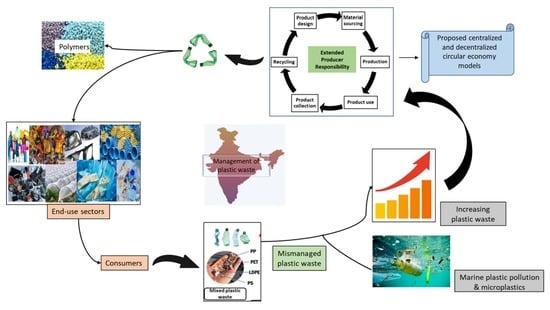
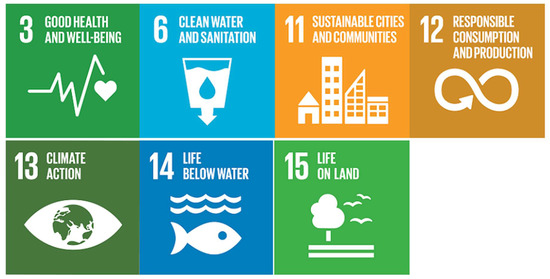
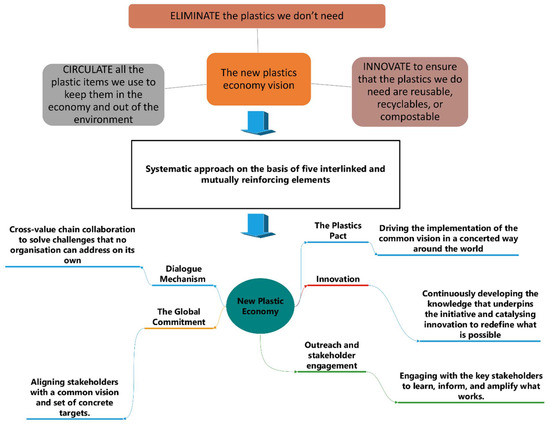

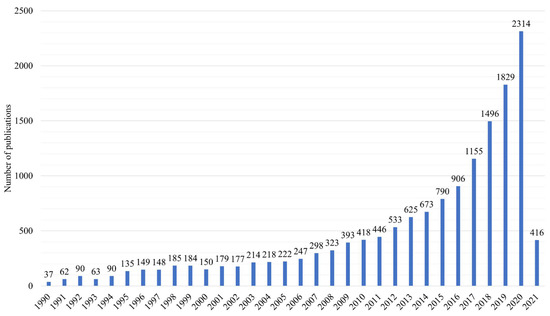
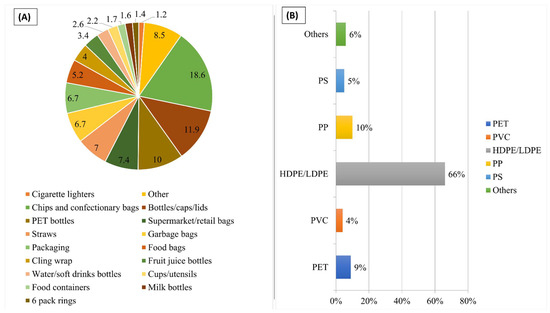
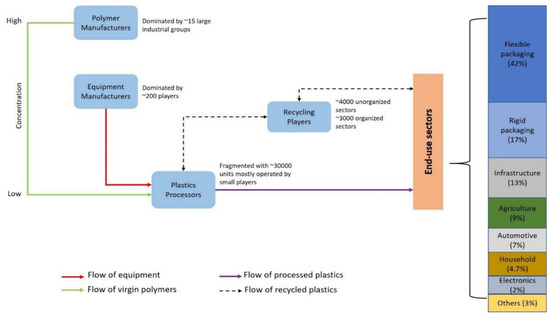
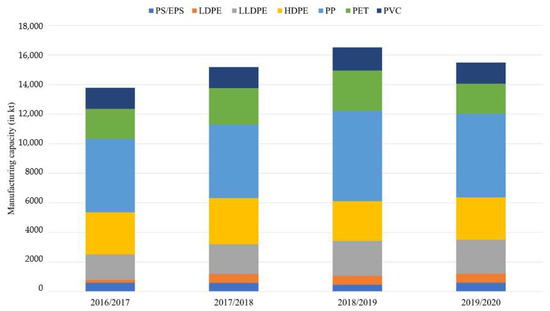
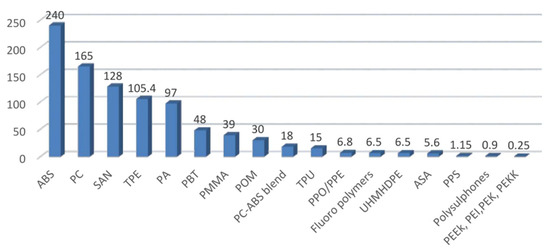
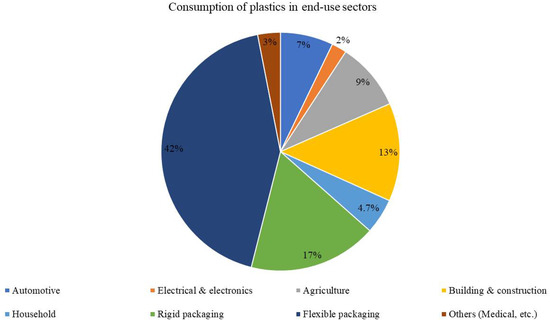
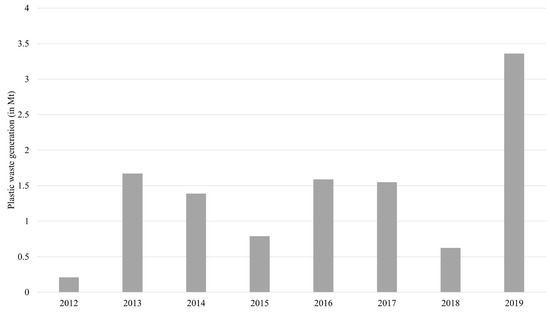
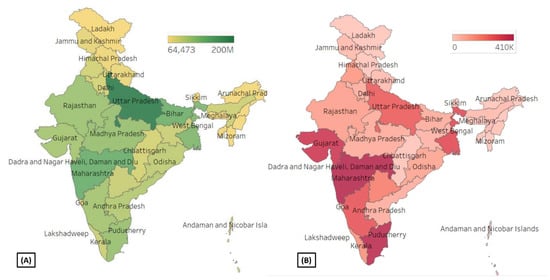
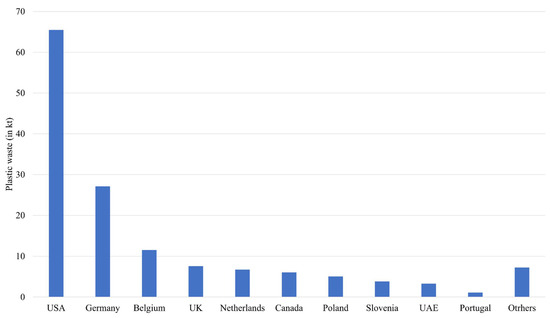
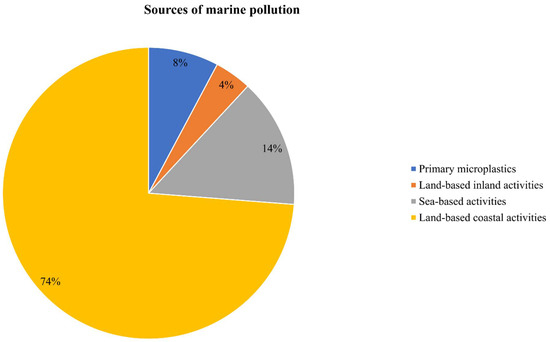
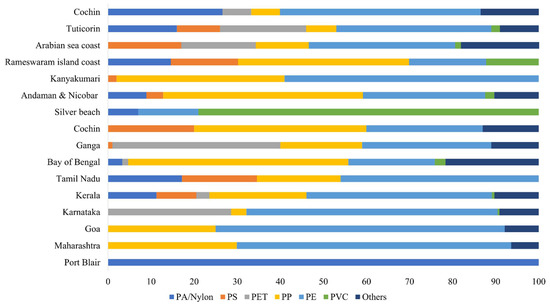
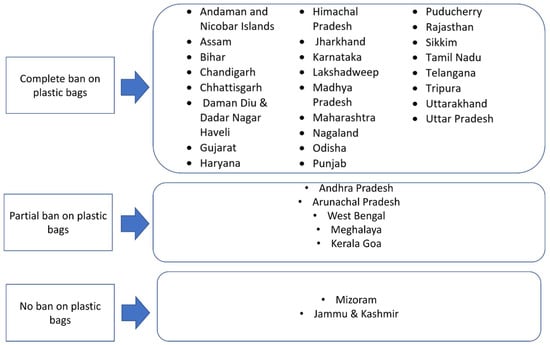
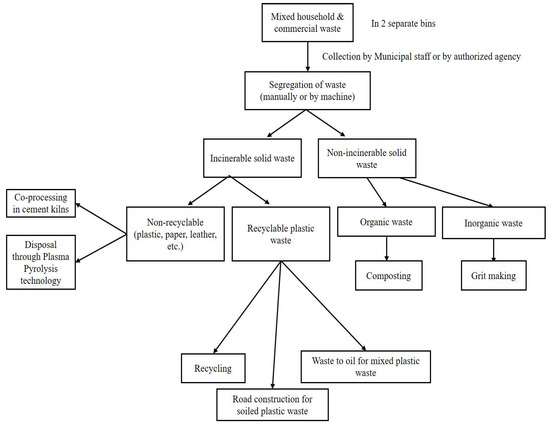
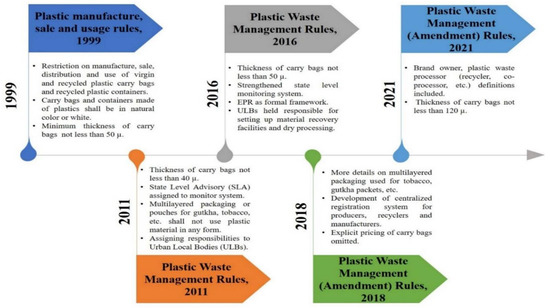
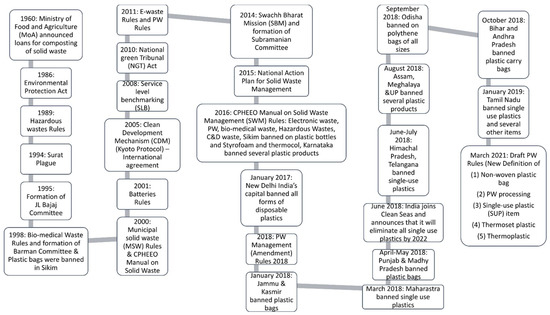
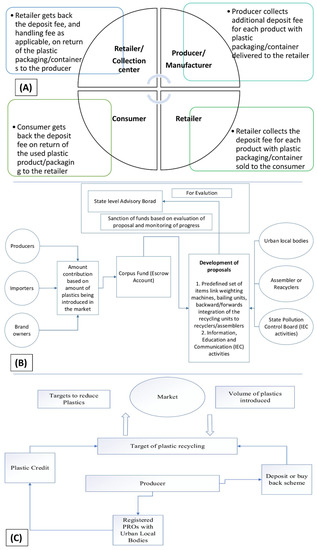
No comments:
Post a Comment